Mississagi River
Ontario, Canada
June 19 - 27, 1992
The Mississagi has a long history of use by man from the earliest hunting and fishing by native peoples through white traders and trappers of the 1700's and 1800's. Our trip was through the Mississagi Provincial Waterway Park, a portion of the route preserved for recreational use. The area remains quite beautiful and we enjoyed some excellent campsites and we were able to run most of the rapids we encountered. However, for us, the experience was somewhat marred by the incurrsions of civilization: logging roads, clearcut logging, fishing boats, ATV tracks, and overused and abused campsites. Nevertheless, this trip included episodes that we still fondly recall, including: after-dinner mints for marauding bears; the short-sheet incident; Mister Moose; the miracle outhouse, and the night black flies routed us. This journal was written by Jim Brown. - L. Walter
Friday, June 19
Hectic prelude; loading the vehicles.
As usual for one of these trips, a very hectic scenario preceded our departure. Christopher's baseball game had lasted until 9:00 that evening, and afterwards we had come home to work frantically on preparing for a neighborhood garage sale the following day. (These preparations included completely rearranging my study, which made it difficult for me to finish packing for the trip.) Emily had made some baked goodies to serve the voyageurs during their brief stop at our waystation. Our clothes dryer had broken down; so she was up at the laundromat when the crew began to arrive.
Taylor had called me at work to say that he probably wouldn't arrive until after 11:30 PM because Lisa had a dance recital that evening. Walter had worked desperately in the final days to tie up loose ends so that he could get away from work. Rob simply got permission from his boss and left, but he expected some major fallout as his cohorts floundered about in the wake of his departure. Doug had been especially busy ordering, repackaging, organizing, and packing all the food in Hellpack. [Taylor had picked up Hellpack from Walter's back door on the way home from Canoe School, and then one afternoon had left it at his own front door for me to pick up on the way home from work. I in turn had delivered it to Doug in the Ford WHQ parking lot several days later.]
Walter had called a couple days earlier to let me know that he and Rob would be leaving his house around 6:00 PM; so they expected to reach Brighton around 11:00. In fact, they arrived only a few minutes after 11:00 with the Tripper atop Walter's Toyota. Doug arrived with the Aerostar just before 11:30, and the Taylors showed up a few minutes later with the Explorer atop their Acura.
Peter's latest girlfriend had left her car halfway up the left side of the driveway, then departed with Peter in his car, taking her keys with her. Walter had to pull in behind her car. When Doug arrived, he pulled the Aerostar up the right side of the driveway to a position near the garage so that we could take advantage of the garage floodlight to mount the canoes.
We decided to load most of the gear into the Aerostar so that we could test its capacity right away.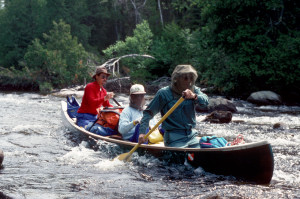 After considerable thought on the matter (including several discussions with me in our PROFS electronic mail system at work), Doug had decided to remove the two captain's chairs from the middle of the Aerostar and retain the bench seat in the back, both for seating and as a gear rack. Room in the Aerostar was at a premium, but there was enough to accommodate both the gear and three passengers comfortably. In the end, only my tent went into the Probe. Since we were going to pay a ranger to shuttle the Aerostar from the put in to the take out, the Probe would not really be needed for the trip. We decided to take it anyway for two reasons: to avoid cramped conditions during the 10 hour trip up to Ontario and to provide a "chase" vehicle in case the Aerostar had any mechanical problems.
After considerable thought on the matter (including several discussions with me in our PROFS electronic mail system at work), Doug had decided to remove the two captain's chairs from the middle of the Aerostar and retain the bench seat in the back, both for seating and as a gear rack. Room in the Aerostar was at a premium, but there was enough to accommodate both the gear and three passengers comfortably. In the end, only my tent went into the Probe. Since we were going to pay a ranger to shuttle the Aerostar from the put in to the take out, the Probe would not really be needed for the trip. We decided to take it anyway for two reasons: to avoid cramped conditions during the 10 hour trip up to Ontario and to provide a "chase" vehicle in case the Aerostar had any mechanical problems.
After the canoes were secured, we had to figure out where to store Walter's Toyota van so that it would be safely out of the way of the garage sale. We considered putting it in the garage, but that would have meant removing the canoe rack from the van and the sale items from the garage. We finally decided to put it in front of Peter's girlfriend's car. During the attempt to maneuver around the car, however, the rack on Walter's van brushed against the rack on the Aerostar, producing a loud cracking noise. We were concerned about damage to the Aerostar's rack, on which we would be depending for the next 12 hours. But instead the damage was to the Toyota's canoe rack and rain gutter. The gutter and one of the rack clamps were bent enough so that the rack no longer securely fastened to the top of the Toyota. We paused for 15 minutes to repair the damage so that we could be sure Walter would be able to transport his canoe back to West Chester on the return trip. The solution turned out to be a metal washer which, when applied to the clamp, produced enough tension to compensate for the damage.
Saturday, June 20
The drive northward through the night; breakfast in Thessalon; Peshu Lake Road to Rouelle Landing; Wakami Provincial Park; trip to the access point on Spanish Lake; Portage #4; Island campsite on Barney Lake; Early to bed.
At last we were ready to depart. The time was 1:15 AM. The night air was chilly (about 50°), and a misty drizzle was falling. I started out driving the Probe, with Walter at shotgun. Doug was at the helm of the Aerostar. We stopped briefly in Hartland to top off the Aerostar's fuel tank, then headed north on US 23.
The drive went more or less uneventfully. Intermittent spells of rain gave us mixed signals about the weather we could expect to find up in Ontario. We paused again near Grayling for Taylor to take over driving the Aerostar. At this point the Aerostar seating arrangements seemed to be working out well. While one person road shotgun, conversing with the driver to keep him awake, the third person could more or less sack out on the bench seat in the back. Things were not going so well in the Probe, though. During this stop, I should have switched with Walter, but I thought he should try to rest a bit more after his 5 hour trek from West Chester to Brighton. Unfortunately I was so tired that I had to fight to stay awake between Grayling and Mackinaw City. Meanwhile Walter couldn't really rest because he was worried (with considerable justification) that I would fall asleep at the wheel.
As we approached the Straits of Mackinac, the sky began to clear somewhat, and hints of a sunrise could be seen through the broken clouds on the eastern horizon. At around 5:30AM we stopped at Mackinaw City to refuel both vehicles. To my pleasant surprise we found an open Total station that took my "frequent fueler" card. There Walter at last took over driving the Probe.
We continued across the Mackinac Bridge, through the Upper Peninsula, across the Soo, and into Sault St. Marie. Rob wanted to dine at Smiley's Restaurant, where we had had breakfast on the Wakami trip two years earlier. But Walter was determined to avoid Smiley's, partly because it was a kind of "tourist dive", but mostly because it was out of the way of our intended course east on Route 17.
We eventually stopped for breakfast at a restaurant next to the Carolyn Beach Motel in Thessalon. The time was about 8:00AM, and the weather was cloudy, cold, windy, but dry. This restaurant turned out to be a real find. It was clean, uncluttered, pleasantly decorated, and had a nice view of a bay opening out into Lake Huron. The food was excellent and reasonably priced, and the coffee was exceptional. Walter and I had pancakes, while Taylor and Doug each had a full fledged egg meat and potato plate called "The Boss".
After breakfast, Rob took over driving the Probe, and Doug took the wheel of the Aerostar again. About a mile away, at the intersection of Routes 17 and 129, we stopped at a relatively new store called the Outfitter Supply Company to get our camping permits and fishing licenses. At that hour we had the place all to ourselves; so we were able to take care of those transactions quickly. I looked around for an inflatable pillow to bolster my quallo fill Slumberjack pillow, but no luck. A room in the back of the store featured a large water tank full of live bait and an expansive wall map of the entire area. Walter showed Rob where on the map we were headed and specifically pointed out the turn off from Route 129 to Peshu Lake Road.
About an hour later, as I napped in the seat beside him, Rob raced ahead of the Aerostar on Route 129 and missed the turn off to Peshu Lake Road. After a while, he noticed that the Aerostar was no longer following us. He made an abrupt U turn (which woke me up) and headed back south on Route 129, where we eventually encountered the Aerostar waiting at the turn off.
Peshu Lake Road turned out to be an 18 mile long, winding, single lane track full of rocks, ruts, and potholes.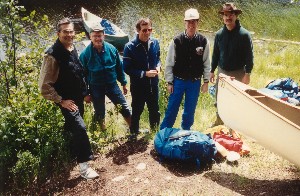 Along the way we passed a crude airstrip, a veritable RV village of fisherman near a lake, and a junky looking lodge where we thought we might be able to shower on the return trip. At times I worried that the Probe, with its low clearance, would not survive the journey down this primitive road. The passage was pretty, though, especially along Peshu Lake itself, and both vehicles made it to Rouelle Landing (our take out point) without incident.
Along the way we passed a crude airstrip, a veritable RV village of fisherman near a lake, and a junky looking lodge where we thought we might be able to shower on the return trip. At times I worried that the Probe, with its low clearance, would not survive the journey down this primitive road. The passage was pretty, though, especially along Peshu Lake itself, and both vehicles made it to Rouelle Landing (our take out point) without incident.
At Rouelle Landing, we paused to get a good look at the surroundings so that later we could be sure to find the take out point from the water. Those of us wearing lightweight clothing quickly changed into warmer garb. We also moved some gear around in an attempt to free up more space. In the process, Taylor discovered that his canister of Jim Beam had somehow leaked, leaving his therm a rest pad and towel saturated with bourbon. As it turned out, the smell of bourbon persisted in his gear for several days. After transferring my tent from the Probe to the Aerostar, I backed the Probe into a small weedy clearing in the woods and locked it up. Then we all boarded the Aerostar and headed down Peshu Lake Road back to Route 129.
Once on Route 129, we decided to backtrack a couple of miles to fuel up at Johnny's Can Op Truckstop before proceeding north toward Wakami Provincial Park to pick up the ranger. The weather was still very chilly and windy, and even the female gasoline attendant complained about the unseasonable cold. At this point conditions in the Aerostar were so cramped that we could hardly imagine cramming another person into it. What's more, with gear stashed all over the place, bodies contorted to the remaining space, and the smell of bourbon in the air, the interior of the Aerostar resembled an alley on skid row.
We reached Wakami just after noon almost an hour ahead of schedule. The ranger, Scott Milne, was just starting lunch, so we took a brief tour of the park headquarters, then adjourned to the Aerostar to wait for him. While waiting, we broke out our first snack packs. We were amazed at the changes to the headquarters building since our Wakami trip two years before. Expansion and redecoration had transformed it from a rude hovel, with all the charm of a military quonset hut, to a spacious, attractive, log cabin style visitor center with some features one would expect to see in a resort. The work was obviously not yet completed, but it was clearly headed in the right direction.
Scott Milne joined us shortly before 1:00 PM, and we managed to shoehorn him into the Aerostar. We set out for Spanish Chutes along logging roads we expected to resemble the murderous road we had taken to Biscotasing 11 years earlier for the Sakatawi canoe trip. Instead, the old roads had been greatly improved (better grading, finer gravel, stop signs, etc.), and in many cases new roads had been added, to the extent that our route to Spanish Chutes did not correspond to anything on Walter's topographical maps. As much as we appreciated the smoother ride, though, we were disturbed at the inroads the logging industry had made into this country and worried that improved access would soon eliminate the wilderness itself.
Scott Milne turned out to be as much a guide as a shuttle. He informed us that the Department of Natural Resources permits him to do these shuttles only on his own time on a not for profit basis. [He contributes the $100 shuttle fee to a "morale fund".] He also shared with us a wealth of information about the Mississagi route, including campsites and points of sightseeing interest, and about more general matters, such as canoeing opportunities and logging activities in the Chapleau District. He mentioned that about 200 people per year do the Mississagi trip, mostly in July, and he related a few anecdotes about some of the voyageurs he had encountered. For example, he described a couple of canoeists who had recently attempted to do the Wakami trip (which we had done two years earlier) using only an automobile roadmap. After only a day, they became hopelessly lost, and the rangers had to go "rescue" them!
We had decided to put in at Spanish Chutes rather than Biscotasing (the usual start of the Mississagi route) to avoid over 25 miles of canoeing on Biscotasi Lake and Ramsey Lake, where we were concerned about encountering motorboats and stiff headwinds. Scott now suggested that the new roads would enable us to put in on an arm of Spanish Lake just beyond Spanish Chutes. In this way, we could avoid a soggy 500 meter portage around rapids on the Spanish River. Since we were all very tired from the drive, we immediately accepted his suggestion. After an hour and a half drive we reached the proposed put in point along the road between Ramsey and Espanola. The put in, which was about 60 meters down a winding trail from the road, was somewhat swampy, with access to the water across an expanse of muck. By repositioning some wooden pallets that were embedded in the muck, we managed to create a passable loading dock.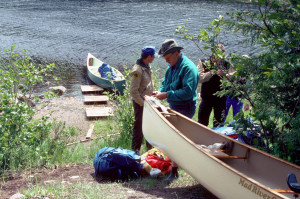 After a certain amount of disorganized milling about, we finally managed (much to Scott's amazement) to get all the gear and personnel into the canoes and were ready for departure.
After a certain amount of disorganized milling about, we finally managed (much to Scott's amazement) to get all the gear and personnel into the canoes and were ready for departure.
Walter took the stern of the Tripper; I took the bow, and Rob took a seat in the middle for fishing. Taylor took the stern, and Doug the bow, of the Explorer. With only a few exceptions, we would maintain this configuration throughout the trip. In a sense, we were recreating the conditions of our Sakatawi and White River trips, which Walter, Rob, and I had done in the Tripper before Taylor and Doug had joined the group.
We set out across Spanish Lake into a wind that was both cold (48°) and stiff (20 25 mph). The time was about 4:00 PM. The wind whipped up substantial waves, but partly sunny skies and the complete absence of bugs made these conditions seem fairly pleasant. After paddling for only half an hour, we pulled into the relatively calm lee of an island so that Walter could get out his compass and take our bearings against the map. Rob began to fish but almost immediately snagged his lure, which he had cast out into the rougher water. The result was another in an ongoing series of Rob vs. Walter squabbles: Rob wanted to go into the rough water to free up his lure, but Walter wanted to stay in the calm water to consult the map and compass. To end the squabble, I attempted to move the canoe closer to the snagged lure, but with limited control from the bow, I succeeded only in moving the canoe out into the wind, where it blew away from the lure and into still rougher water. Meanwhile Taylor and Doug watched from the calm water and laughed at this comedy of errors. Fortunately Walter was soon finished with his deliberations. We quickly took control of the canoe, fetched the lure, and continued on our way.
We soon reached Portage #4 (having skipped the first three portages of the regular route with our alternative put in). This portage would be our only one of the day and our only "upstream" portage. A 150-meter trail on the left took us around a creek that flowed from Bardney Lake into Spanish Lake. A small dam at the head of the creek had a crude winch and cable mechanism attached to a large wooden beam that was apparently used to raise and lower the water level of Bardney Lake. A set of typical warning signs tried to suggest that the dam was dangerous, but it looked innocuous enough for us to venture out on it for photographs.
Once under way again, we began to look for an island campsite that Scott Milne had told us we would find out in Bardney Lake. The time was about 6:00 PM, and the wind seemed to be getting stronger. We soon spotted the island Scott had described and made our way toward it. The island was small, but heavily wooded and surrounded by large, angular rocks. As we approached, the waves threatened to smash us against the rocks or swamp us from the stern. The only promising landing area was rocky and partially exposed to the wind, but we managed to dock without incident, despite the increasingly severe elements. At this point we were all very cold, especially our hands, and we looked forward to setting up camp and finding some shelter from the wind.
The campsite had obviously been used many times before, probably more by fishermen than by canoeists. 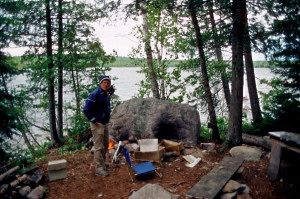 The "kitchen" area had a crude bench next to a hearth formed by a ring of rocks placed against a large boulder. There was plenty of seasoned firewood, both chopped wood and driftwood, but also plenty of litter: scruffy corrugated cardboard boxes, rusty fuel cans, tangled mats of string, wads of paper, and bunched up sheets of plastic. We were thankful for the firewood, but distressed about the litter. [During the course of our stay, though, we managed to burn up most of the litter and eventually left the site cleaner than we found it.]
The "kitchen" area had a crude bench next to a hearth formed by a ring of rocks placed against a large boulder. There was plenty of seasoned firewood, both chopped wood and driftwood, but also plenty of litter: scruffy corrugated cardboard boxes, rusty fuel cans, tangled mats of string, wads of paper, and bunched up sheets of plastic. We were thankful for the firewood, but distressed about the litter. [During the course of our stay, though, we managed to burn up most of the litter and eventually left the site cleaner than we found it.]
The campsite had limited sheltered space for tents, and the available space was somewhat unlevel and peppered with rocks and roots. Walter and Rob claimed a tent site not far from the kitchen area. I located a somewhat less level spot in the middle of the island. We pitched my Eureka Overlander tent behind a huge boulder, which afforded us some protection from the wind. Doug, Taylor, and I had the Overlander set up within a mere five minutes; so while Walter and Rob were still struggling with Walter's Sierra Design Octodome tent, I was able to work on getting a fire started.
The wind, which was virtually howling across the water and through the trees, made it difficult to establish a fire. Fortunately the sheltering construction of the hearth and the abundance of dry kindling gave us a fighting chance. Using what Rob called the "Ronco Executive Fire Starter Kit", I soon had enough of a fire going that we could set up the grill and start boiling water for dinner. The executive fire starter kit was a plastic file box in which I had placed my Whisperlite campstove, two bottles of fuel, various kitchen utensils, and several boxes of waterproof matches.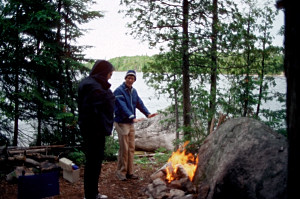 The matches were actually the only item used to start the fire the "active ingredient", so to speak but the kit looked pretty impressive.
The matches were actually the only item used to start the fire the "active ingredient", so to speak but the kit looked pretty impressive.
Dinner consisted of beef stew and apple brown betty. Doug had repackaged everything in ziplock bags neatly labeled as to content and amount of hot water required. All we had to do was add the specified amounts of hot water, mix thoroughly, allow the bags to sit for a few minutes, eat out of the bags, then throw them in the fire. No trash and no dishes to clean up! This scheme met with immediate and unanimous approval.
The meal was delicious, but more importantly, it helped to warm everyone up a bit. Soon after dinner, however, we all decided to turn in. The time was only 8:30 PM, but we were all completely exhausted from the long drive and lack of sleep, and the cold wind chased away any thoughts of lingering around the campfire. In the Overlander, Taylor, Doug, and I took the left, right, and middle sleeping positions respectively positions we would maintain for the entire trip. We quickly fell asleep to the steady rushing sound of the wind.
Sunday, June 21
Breakfast and a complicated food distribution scheme; cold and windy morning; Rob catches two pike; portage to Sulfer Lake; portage to Surprise Lake and unanticipated black flies; portage to Circle Lake and a moose sighting; short portages to Mississagi Lake battling black flies and a fallen tree; locating and traversing the channel to Green Lake; camp at the burned ranger cabin; bear precautions.
Dawn came with temperature in the 30's and the wind still blowing steadily from the north at 20 25 mph. It was hard to believe this was the Summer Solstice the longest day of the year and the first day of the "warm" season! Still, we all roused ourselves between 7:30AM and 8:00 AM relatively refreshed and ready for breakfast.
I managed to start a fire again, and Rob fetched some water in the 2 quart and 4 quart cooking pots. The water took a while to boil because of the wind. Walter, who tended to be a bit surly before his morning coffee, grew impatient with the lack of progress. He decided to take matters into his own hands and tried to start up his campstove. But before he could get the stove going, the smaller pot over the fire finally reached a boil.
At this point, Doug distributed both the breakfast and snack packets for the day. Breakfast consisted of bagels, hot cereal, poptarts, coffee and/or cocoa. All subsequent breakfasts on the trip would consist of these same items, although the bagels and poptarts would be different flavors, and the cereal could be eaten cold in some cases. Doug had tried to individualize the breakfast and snack packets to some extent.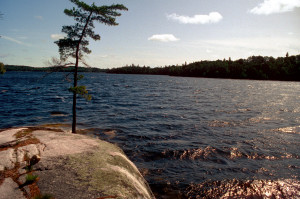 He had used a rather confusing coding scheme to indicate the contents of each packet, and as a result, the wrong packets fell into the wrong hands. Matters were soon resolved with a few deft trades, but we quickly came to the conclusion that Doug himself had already reached: The best way to individualize everyone's food supply (on future trips) would be for everyone to bring his own food.
He had used a rather confusing coding scheme to indicate the contents of each packet, and as a result, the wrong packets fell into the wrong hands. Matters were soon resolved with a few deft trades, but we quickly came to the conclusion that Doug himself had already reached: The best way to individualize everyone's food supply (on future trips) would be for everyone to bring his own food.
After breakfast, Walter used his new MSR water filter to prepare almost two gallons of drinking water for the whole crew. With its lever action pump and detachable pre filters, this device was easy to use and amazingly effective. Most of the water would be flavored with powdered drink mixes from the snack packets. Snack packets included discrete bags of nuts, dried fruit, "party mix", hard candies, granola bars, and powdered drink mix (either Gatorade or Crystal Light). Here again, all subsequent snacks would consist of variations of these same items. The quantity of food and caloric content of these snack packets would, for the most part, render superfluous the lunch packets Doug had also prepared.
Because we had not yet got into any particular routine, the attempt to break camp was disorganized and inefficient. However, the trip was well ahead of schedule at this point because of our alternative put in; so nobody was in any particular hurry. We finally managed to get out on the lake at around 11:15 AM.
The wind was stronger than ever a steady 25 mph from the north but the skies were clear, and despite the cold air, we soon warmed to the task of canoeing in the bright sunlight. Fortunately we were headed south, so the wind pushed us along, and little paddling effort was required as we rode waves that were tall enough to have whitecaps. We found that we could even raise our paddles into the wind and "sail" along without paddling at all. But Walter and Taylor found it difficult to steer the canoes. The wind constantly threatened to swing the canoes around to a broadside position in which the huge waves could easily swamp them. We were increasingly thankful that we had not started the trip at Biscotasing. Making our way across the open expanse of Ramsey Lake, largely headed into the wind, would have been a harrowing experience.
While we sailed along Bardney Lake, Rob fished with some success. He caught two pike (2 3 pounders) with his Hots'n'Tots lure, but then lost the lure on a snag. 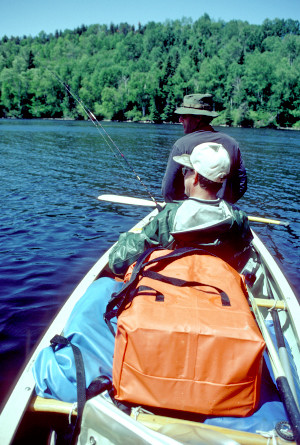 Each catch raised somewhat of a problem for the Tripper because the optimum position for Rob to haul in the fish was a less than safe position for the canoe in the wind. Nevertheless, we managed to keep the canoe under control, and Rob's early fishing success lifted our spirits to the prospect of delicious fish dinners later in the trip. As it turned out, these auspicious signs would later prove to be a kind of cruel hoax.
Each catch raised somewhat of a problem for the Tripper because the optimum position for Rob to haul in the fish was a less than safe position for the canoe in the wind. Nevertheless, we managed to keep the canoe under control, and Rob's early fishing success lifted our spirits to the prospect of delicious fish dinners later in the trip. As it turned out, these auspicious signs would later prove to be a kind of cruel hoax.
As we approached the south end of Bardney Lake, Walter and I thought we saw a portage sign directly ahead, more or less where the topographical map indicated. But it turned out to be only a patch of sunlight. Then Rob spotted the sign in a completely unexpected place over on the west bank. We landed the canoes and began Portage #5, a 430 meter trail from Bardney Lake to Sulfur Lake. This trail crossed the height of land between the Spanish and Mississagi watersheds. From this point on we would be traveling "downstream" toward Lake Huron. The trail rose more or less continuously for about 350 meters, then dropped quickly to Sulfur Lake. It was lined with wildflowers notably moccasin flower (related to lady's slipper) and bunchberry (whose blossoms resemble dogwood) and punctuated in spots with piles of moose scat.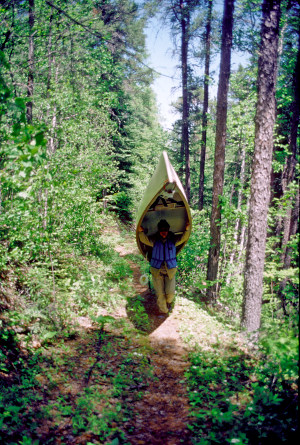 A fallen tree at about the midway point angled over the trail in such away, and at such a height, that we were forced to pass the canoes under it. Once over the hill, we began to encounter mosquitoes and black flies for the first time. The temperature had risen quickly into the 60's, and the bugs were pretty much protected here from the north wind. Returning up the trail to fetch the rest of the gear, we encountered a ruffled grouse, which skittishly rustled about in the underbrush, presumably trying to draw us away from its nest. Despite a previous disastrous encounter with this species of bird on the White River trip, Rob appeared to be safe from attack on this occasion.
A fallen tree at about the midway point angled over the trail in such away, and at such a height, that we were forced to pass the canoes under it. Once over the hill, we began to encounter mosquitoes and black flies for the first time. The temperature had risen quickly into the 60's, and the bugs were pretty much protected here from the north wind. Returning up the trail to fetch the rest of the gear, we encountered a ruffled grouse, which skittishly rustled about in the underbrush, presumably trying to draw us away from its nest. Despite a previous disastrous encounter with this species of bird on the White River trip, Rob appeared to be safe from attack on this occasion.
Once the canoes were reloaded, Taylor and Doug took the Explorer across Sulfur Lake while the rest of us paused to change into cooler clothing and apply bug dope. We had to traverse only the northern arm of Sulfur Lake; so we soon reached Portage #6, a 200 meter trail to Surprise Lake. Along this trail we noticed bear scat in several spots. At trail's end we encountered black flies in numbers that, for the first time, suggested the little beasties were going to be a real problem on this trip. Scott Milne had led us to believe that black fly season was pretty much over, and on two previous trips at this time of year (Sakatawi, White River) we had encountered no black flies at all. So we were surprised and disturbed at this development.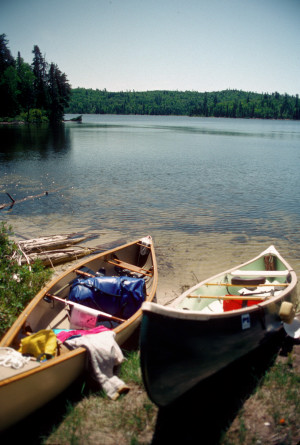 In a way, it was poetic justice (or maybe poetic injustice) that we should first realize our plight on the banks of Surprise Lake. Perhaps we should have renamed it "Unpleasant Surprise Lake".
In a way, it was poetic justice (or maybe poetic injustice) that we should first realize our plight on the banks of Surprise Lake. Perhaps we should have renamed it "Unpleasant Surprise Lake".
We were hungry enough for a snack now, but we wanted to be free of black flies while we ate; so we paddled out to the middle of Surprise Lake, where the breeze would blow the little buggers away. The wind had died down considerably now, but it was still strong enough to give us relief from the critters. We drifted for a while, snacking, fishing, filtering water, and generally enjoying the now beautiful weather. Today's snack featured dry cherries, which turned out to be an unqualified crowd pleaser.
We continued across Surprise Lake, but as we approached the south end of the lake, Walter pointed out that the next portage would be one kilometer the longest of the entire trip and that the next couple of lakes would be too small to afford us much protection from bugs. Even though we had stopped for a snack only a short time before, we made a tactical decision now to stop for lunch. Again we drifted for a while in the pleasant breeze as we consumed gouda cheese and summer sausage on Tuscany toast and bagel chips. It was at this point that we first realized it would be difficult to eat both the prepared snack and the prepared lunch in a single day. There was simply too much food, and everyone felt a bit bloated after lunch. In subsequent days, we pretty much abandoned lunch.
The portage (#7) from Surprise Lake to Circle Lake began in a boggy area with "beveled" logs laid across the muck as makeshift footbridges. At water's edge we noticed clumps of blue flag, a relative of the iris.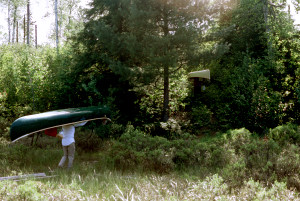 Away from the lake, the trail rose steeply in several spots through groves of trees with low hanging branches, making it difficult for anyone carrying a canoe. By this time we had all donned headnets for protection from the swarming black flies. Rob started out carrying the Tripper, then was relieved by Walter, who got stuck with the steep sections of the trail. I in turn relieved him. Taylor carried the Explorer the entire way. Doug carried Hellpack and was the first to reach the end of the trail. He was rewarded with our first and only moose sighting, a large cow. By the time the rest of us reached trail's end, though, the moose had ambled off into the woods on the other side of the lake, and we never did see it.
Away from the lake, the trail rose steeply in several spots through groves of trees with low hanging branches, making it difficult for anyone carrying a canoe. By this time we had all donned headnets for protection from the swarming black flies. Rob started out carrying the Tripper, then was relieved by Walter, who got stuck with the steep sections of the trail. I in turn relieved him. Taylor carried the Explorer the entire way. Doug carried Hellpack and was the first to reach the end of the trail. He was rewarded with our first and only moose sighting, a large cow. By the time the rest of us reached trail's end, though, the moose had ambled off into the woods on the other side of the lake, and we never did see it.
Circle Lake was just an oversized pond what our brochures described as a "pothole". We canoed across it quickly to Portage #8. This portage trail was only 90 meters long and led to another pothole, this one unnamed and even smaller. The put in point was somewhat awkward, and in loading our gear into the Tripper, Rob and I found ourselves in positions that would have made it difficult for us to take our usual places in the canoe. Since this lake was too small for fishing, we decided that Rob should go ahead and paddle in the bow while I sat in the middle of the canoe.
We crossed the tiny lake in just a few minutes and reached Portage #9, a 90-meter trail to Mississagi Lake. This trail was completely blocked by a huge spruce that had fallen almost lengthwise on the trail, its lateral branches (now vertical) forming a formidable barrier. Doug attempted to bull his way through this obstacle with Hellpack on his back. He managed to get through, but not without falling over backwards at one point. Rob and I, who were carrying the Tripper and the Explorer respectively, had to drop the canoes just short of the obstacle, creating a major traffic jam. Rob, Doug, and Taylor began pulling branches over, trying to snap them down to make way for the canoes.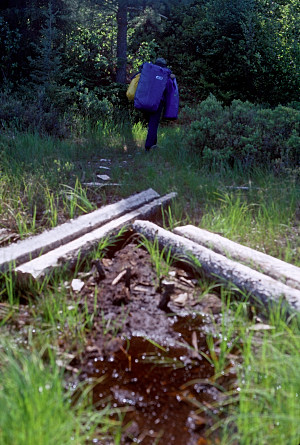 I returned to the start of the trail in search of an ax. Walter brought the ax and began hacking away at the barrier while I fetched more gear to add to the traffic jam. Meanwhile, Rob and Doug managed to work the Tripper through the limited space they had cleared. Taylor finished portaging the Explorer through the somewhat larger space cleared by Walter. During this struggle, we were drenched with sweat (the temperature was now about 70°) and under relentless attack from the black flies. We were all glad to reach the end of this portage!
I returned to the start of the trail in search of an ax. Walter brought the ax and began hacking away at the barrier while I fetched more gear to add to the traffic jam. Meanwhile, Rob and Doug managed to work the Tripper through the limited space they had cleared. Taylor finished portaging the Explorer through the somewhat larger space cleared by Walter. During this struggle, we were drenched with sweat (the temperature was now about 70°) and under relentless attack from the black flies. We were all glad to reach the end of this portage!
Once we were under way again, we noticed over on the east bank of Mississagi Lake what appeared to be the foundation of an old cabin. The surrounding area looked like a promising campsite, but it was still pretty early (about 4:30 PM), and we decided to press on in search of a Green Lake campsite that had been recommended to us by Scott Milne. The wind continued to blow strongly at times and at one point blew Doug's vest out of the Explorer into the water. Fortunately the vest was buoyant enough to stay afloat until we could retrieve it.
The lake narrowed in several different spots and at one point became shallow, with large boulders just below the water's surface. Poles with orange flags marked a channel for motorboats through this rocky minefield. At the south end of Mississagi Lake we began to look for a narrow outlet channel that was supposed to lead into Green Lake. Taylor and Doug were approaching the southeast corner of Mississagi Lake when Walter determined from the map that the channel would probably be in the southwest corner. We changed directions back partially into the wind, and Taylor and Doug followed. After rounding several wooded points, beyond each of which we expected to find the channel, we reached a dead end. Walter then realized that he'd got the directions reversed because he had to follow our south oriented course upside down on the north oriented map. Again we altered course and headed partially into the wind back toward the southeast corner of the lake. We found the channel just about where Taylor and Doug had been heading in the first place.
The channel was indeed very narrow. At one bend in the channel the way was partially blocked by huge boulders which projected above the water and produced a swift current that we negotiated without incident. Shortly afterwards we came upon a fishing lodge perched on a narrow spit between the channel and Green Lake. Supposedly this lodge now occupied the site of a former North West Company outpost. A line of aluminum boats on the bank suggested that the lodge was prepared for a major influx of fishermen later in the summer. Scott Milne had suggested that we stop for coffee with the friendly American couple who owned the lodge. But we did not see anyone there and, at this late hour, were not inclined to land and go looking for company.
The channel made a broad curve from this point to a sandy opening onto Green Lake. We entered Green Lake at about 7:00 PM and began looking in earnest for the campsite recommended by Scott Milne. We started up the northeast arm of the lake. Walter mentioned that the site was supposed to be on a bluff near an observation tower, but we didn't see a bluff or a tower. Assuming the tower would be on a high point of land, I pointed at a spot on the northeast shore and remarked, "There's the highest point of land, but there's no tower on it." Walter looked over to where I was pointing and replied, "There's the tower!" Evidently it was time to replace my glasses.
With a landmark to head for, we were confident we'd find the campsite, even though there was still no sign of it. After several false alarms (patches of sunlight, swatches of dead foliage, etc.) we finally spotted a bonafide orange campsite sign and set a course for it. We paddled the canoes into a rocky shoreline from which projected a short, dilapidated dock. From the dock a decayed log and earth stairway climbed the steep bank to a somewhat uneven campsite heavily infested with black flies.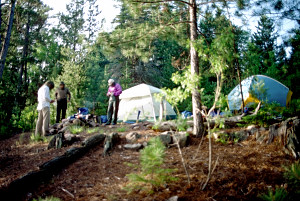 The site had a nice fire ring, again with plenty of seasoned firewood, and there were several crude benches for seating and food preparation. Behind the campsite were the burnt out remnants of a long abandoned cabin, presumably accommodations at one time for the Forest Service personnel who had manned the observation tower. However, the surrounding woods obscured any view of the tower itself.
The site had a nice fire ring, again with plenty of seasoned firewood, and there were several crude benches for seating and food preparation. Behind the campsite were the burnt out remnants of a long abandoned cabin, presumably accommodations at one time for the Forest Service personnel who had manned the observation tower. However, the surrounding woods obscured any view of the tower itself.
We set up both tents on somewhat sloping ground not far from the fire ring, then began preparing dinner. The fire was easier to start here because the woods and hills behind us provided shelter from the wind, but the steep slope down to the lake made it harder to obtain water. Dinner consisted of Honey Lime Chicken, Broccoli & Cheese, and Mocha Mousse Pie. I had first tried Honey Lime Chicken on a hiking trip Doug and I had taken on Isle Royale the previous September, and I was sure it would be a crowd pleaser, as indeed it turned out to be. The Mocha Mousse Pie was also well received. After dinner, we debated whether to hike up to the observation tower. But there was no obvious trail to the tower, and we had reservations about bushwhacking up the hill in the approaching darkness. We decided the hike would make more sense in the morning.
As the sun dropped toward the northwestern horizon, the wind died down, the sky cleared completely, and the temperature fell rapidly. We were surprised how quickly the black flies disappeared. Mosquitoes made a brief appearance, but then they were gone too. We all had to don additional layers of clothing, but we were pleased at the chance to relax around a bug free campfire in beautiful, dry weather. From this campsite we had an impressive view of Green Lake. For a while we could hear loons calling, but the calls seemed to be coming from behind us, as if the loons were not on Green Lake, but rather on a different lake over the ridge behind us.
We talked for a time about plans for the rest of the trip, but conversation soon turned to bears.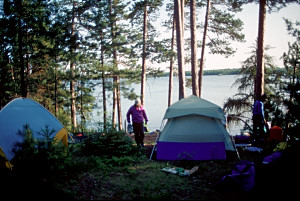 We had seen bear scat on one of the portage trails, and Scott Milne had informed us that the Mississagi basin was home to a sizeable population of black bears. In fact, he had warned us about recent bear activity in this area and reported that three people had been killed by bears in Ontario since the first of the year. This campsite was obviously used pretty heavily, not only by canoeists, who tend to be fairly neat and concerned about leaving wilderness in its original condition, but also by hunters and fishermen, who tend to be more "relaxed" (i.e. sloppy and careless) about such things. There was a good chance, then, that this campsite was regularly patrolled by one or more black bears who had grown accustomed to a fairly regular supply of garbage.
We had seen bear scat on one of the portage trails, and Scott Milne had informed us that the Mississagi basin was home to a sizeable population of black bears. In fact, he had warned us about recent bear activity in this area and reported that three people had been killed by bears in Ontario since the first of the year. This campsite was obviously used pretty heavily, not only by canoeists, who tend to be fairly neat and concerned about leaving wilderness in its original condition, but also by hunters and fishermen, who tend to be more "relaxed" (i.e. sloppy and careless) about such things. There was a good chance, then, that this campsite was regularly patrolled by one or more black bears who had grown accustomed to a fairly regular supply of garbage.
Now, bears who like garbage are one thing. But bears who tear apart tents and people in search of garbage are, as they say, "a whole 'nother ball game". We decided a few healthy precautions were in order. But rather than attempt the standard precautions suspending our food packs (including the agonizingly heavy Hellpack) on a rope dangling from a tree we decided to put the food and food related gear down on the dock away from the campsite. We even located our toothpaste away from the campsite because, according to Scott, bears consider it a real treat. But Rob felt obliged to give the bear something for his trouble; so he left a few after dinner mints by the campfire. Meanwhile, Walter assured us that, because the Overlander was located closest to the campfire, we would be the first target for a marauding bear. With this pleasant thought in mind, we adjourned to our tents and fell asleep to the sound of accelerated heartbeats.
Monday, June 22
An unexpected outhouse; Doug ventures to the tower; portage to Kashbogama Lake; soggy portage to Shanguish Lake; confusion transforms short portage to long portage; Limit Lake and the encroachments of civilization; portage to Kettle Lake; black fly-infested island campsite; Rob lands another pike; refuge from the flies; frantic baths.
Morning came clear and cold, with temperature hovering around 40°. Taylor roused himself early, about 7:00 AM, to start a fire. The wind was gone, but a heavy dew had saturated the available kindling; so he was forced to use one of his fire starter chips. Doug and I were up around 7:30, Walter and Rob somewhat later. So far there were no bugs. Breakfast this morning featured Big Bill's Multi Grain Cereal, which everyone consumed hot except Walter. For the rest of the trip, in fact, Walter stuck with cold cereal for breakfast.
After breakfast, Walter and Taylor went looking for an appropriate latrine in the woods, with moderate success. I had already found a less than satisfactory latrine the night before. We were surprised, then, when Rob announced that he had discovered a 2 seater outhouse behind the charred remains of the cabin. It seems that he had been in the throes of an urgent call of nature and had suffered the extreme anguish of having Walter beat him to the shovel. So he had wandered desperately and aimlessly into the brush and blundered upon the answer to his prayers.
Now Rob led us along an indistinct trail through a thicket of balsam fir trees to an old but solid wooden structure with an open door and a small glass window. He pointed out that one of the holes had been notched out in the front "for someone with a big bag". I immediately decided to fetch some paper from my pack and return for a try out. By this time the mosquitoes were beginning to arrive, but in the confines of the outhouse, one could spot and swat then coming in the door. A bit later, Doug tried out the outhouse and returned to report that it was actually a 3 seater. The third hole was between the other two but had been covered by a wooden cap which we had thought was some sort of decoration.
At about 9:30AM we discussed whether to hike up to the observation tower. There was still no sign of a trail, and now that the bugs were returning, no one was really enthusiastic about bushwhacking up the ridge. Doug decided to go look for the tower anyway. Rob and I decided to go out on the lake for a while so that Rob could fish and I could work on the log without having to fend off the bugs. Walter and Taylor elected to stay in camp.
It took Doug 20 25 minutes to get to the top of the ridge and stumble, almost by accident, upon the tower.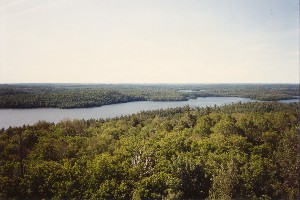 The tower was probably over 30 meters tall, with about 95 rungs to the top and markings indicating that it had been built in 1957. Doug climbed the stairs to the observation deck, which had significantly deteriorated from the weather and was heavily scarred with carved initials. There he took photographs of the panorama of surrounding hills and lakes. He could not see us out in the lake, though. On his way back down the ridge, he came upon a pile of refuse, apparently a dump for the rangers who had once used the tower. There was still no sign of any trail down to the lake; so he continued to bushwhack downhill, on no particular course, until he came quite unexpectedly upon our campsite.
The tower was probably over 30 meters tall, with about 95 rungs to the top and markings indicating that it had been built in 1957. Doug climbed the stairs to the observation deck, which had significantly deteriorated from the weather and was heavily scarred with carved initials. There he took photographs of the panorama of surrounding hills and lakes. He could not see us out in the lake, though. On his way back down the ridge, he came upon a pile of refuse, apparently a dump for the rangers who had once used the tower. There was still no sign of any trail down to the lake; so he continued to bushwhack downhill, on no particular course, until he came quite unexpectedly upon our campsite.
Meanwhile, Rob and I were in the canoe about 50 meters offshore enjoying the cool but magnificent morning. A light westerly wind had sprung up now, but the bright sun kept us comfortably warm. We had to reposition the canoe a couple times because the wind tended to push us toward the southeast away from the campsite. Rob had no luck fishing, but I managed to bring the log up to date. Shortly after 10:00 AM Walter shouted for us to return. Once back in camp, we joined the crew now in process of breaking camp. That chore was soon completed, and we departed for the day's canoeing at around 11:00 AM.
We paddled in a southwesterly direction across the remainder of Green Lake and reached our first portage of the day (Portage #10) just before noon. At this point a narrow stream flowed from Green Lake into Kashbogama Lake. We scouted the stream to determine if it was runnable, but a profusion of strainers from both banks settled the question very quickly. The portage trail was only 90 meters long. At the end of it an aluminum boat was propped up against a tree, suggesting that the fishing lodge on Green Lake extended its influence into Kashbogama Lake. We launched the Tripper first, and as we paddled out into Kashbogama Lake, we noticed a hawk like bird (possibly an osprey or kestral) circling a large nest at the top of a towering spruce tree back near the end of the portage trail. We shouted for Doug and Taylor to take a look, but from their vantage point on the shore, they couldn't get a very good view.
Once under way on Kashbogama Lake, we spotted a small cabin off to the east, and as we reached the middle of the lake, a motorboat from that direction passed behind us heading toward the southwestern shore of the lake. We had thought that by skipping Ramsey Lake, we would avoid such intrusions from civilization. But it was becoming clear that this route was not as much of a wilderness route as we had hoped.
At the southern end of Kashbogama Lake we entered a small bay where we found Portage #11, a 300 meter trail to a channel that flowed into Shanguish Lake. This trail began on a soggy mat that looked like moosemuck and smelled strongly of hydrogen sulfide, but was firm enough to support our weight. The area was swarming with black flies, but the swarms diminished somewhat as we approached the other end of the trail. Propped against a tree at trail's end was another aluminum boat, and just to the west a stream choked with boulders and strainers emptied into the channel. Although this stream was an outlet from Kashbogama Lake, we had not noticed it before because its source was beyond a heavily wooded point of land from the bay where the trail began.
We proceeded down the channel and out into Shanguish Lake far enough for the breeze to blow away the bugs, then paused for snacks. 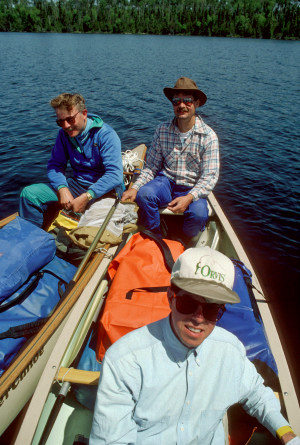 The weather was still beautiful, and the temperature had climbed to about 70°. This lake was one of the prettiest we had encountered, and all along its shores were attractive bluffs that suggested excellent campsite possibilities. We briefly considered camping here, but decided the weather was too nice to stop canoeing so early (it was only about 1:30 PM).
The weather was still beautiful, and the temperature had climbed to about 70°. This lake was one of the prettiest we had encountered, and all along its shores were attractive bluffs that suggested excellent campsite possibilities. We briefly considered camping here, but decided the weather was too nice to stop canoeing so early (it was only about 1:30 PM).
We continued paddling to the southern shore of Shanguish Lake and spotted a portage sign in the middle of what looked like an island around which two outlet streams flowed. Both streams were shallow and full of rocks and strainers. There was no obvious landing or portage trail on the island; so we looked around until we spotted a landing off to the left, the obvious start to Portage #12. As we unloaded the canoes, I decided to try carrying Hellpack, which up to this point had been portaged exclusively by Doug. With a bit of help I managed to get it on my back and discovered that it wasn't quite as heavy as I had expected (of course, we had consumed two days worth of its contents at this point). I carried the pack quickly to the end of trail, which was only about 30 meters long and led to a narrow, shallow channel littered with submerged logs and waterweeds.
Then I returned to help Walter get the Tripper up on his shoulders. Rob already had the Explorer on his shoulders and was moving out. As the crew departed down the trail, I went to load up with more packs, then proceeded again to the end of the trail. To my surprise, I found no one there and, more disturbingly, no canoes or packs other than Hellpack! After dropping off the packs, I returned to the start of the trail to find Taylor just beginning his portage and Doug coming from an ORV track that trailed off into the woods to the east.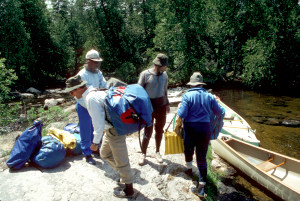 With the canoe obscuring his vision, Rob had apparently missed the portage trail and led Walter and Doug down this track instead. I ventured down the track a ways and found the Explorer sitting in the middle of the track, obviously abandoned by Rob when he had begun to suspect the trail. Walter had continued down the track from this point, the Tripper still on his shoulders, and Rob had gone with him. They were not now in view, but I could hear them returning; so I picked up the Explorer and carried it back down the track and to the end of the portage trail.
With the canoe obscuring his vision, Rob had apparently missed the portage trail and led Walter and Doug down this track instead. I ventured down the track a ways and found the Explorer sitting in the middle of the track, obviously abandoned by Rob when he had begun to suspect the trail. Walter had continued down the track from this point, the Tripper still on his shoulders, and Rob had gone with him. They were not now in view, but I could hear them returning; so I picked up the Explorer and carried it back down the track and to the end of the portage trail.
When the portage was at last completed, everyone was discouraged to have turned a 30 meter portage into a 300 meter portage. We loaded the canoes and proceeded down the narrow channel to Limit Lake. In the process, we crossed under a wooden bridge that had apparently been constructed recently for one of the new logging roads. Most likely this logging road provided access to the ORV track that had fooled us at the last portage. Once again we were disturbed at the rampant encroachment of civilization upon this area. Our discouragement only increased as we rounded a bend in the channel to find a motorboat with two men and a boy fishing for pike and, then again, spotted another motorboat off to the west as the channel opened up into Limit Lake. At around 3:00 PM we paused in the middle of Limit Lake to finish our snacks, to apply sunscreen and bug dope, to fish, and to discuss plans. 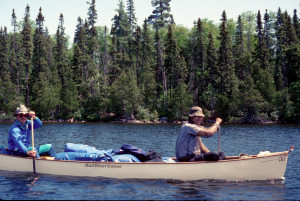 Our original plan had been to camp at the south end of Limit Lake, but it still seemed too early to make camp in such splendid weather, especially since any campsite would be more bug infested than the breezy waters of the lakes. We decided to continue canoeing for at least another hour. As we continued across Limit Lake, we heard the thrilling sound of a loon calling from the middle of the lake, somewhat unusual for this time of day.
Our original plan had been to camp at the south end of Limit Lake, but it still seemed too early to make camp in such splendid weather, especially since any campsite would be more bug infested than the breezy waters of the lakes. We decided to continue canoeing for at least another hour. As we continued across Limit Lake, we heard the thrilling sound of a loon calling from the middle of the lake, somewhat unusual for this time of day.
We soon came to Portage #13, a 60 meter trail around the left side of a set of rapids that led from Limit Lake to Kettle Lake. We considered running the rapids in empty canoes but decided there were too many strainers and pillows. Along this trail the mosquitoes were much worse than the black flies. As soon as we could load the Tripper, we launched out into Kettle Lake, then waited in the open water for Doug and Taylor to load the Explorer. Meanwhile Rob fished, again unsuccessfully.
At about 4:30PM we spotted a promising campsite on an island about a half mile from the rapids. A brief investigation sold us on the site. The island was oblong in shape, and there were campsites at both ends and an additional tentsite near the middle. From the south end of the island we could see a prefab cabin on the east bank of the lake farther to the south; so we decided to camp on the north end of the island. Unfortunately, the north campsite lacked the abundant supply of firewood we found at the south campsite; so we gathered armloads of the firewood and carried it back to the north campsite.
The north campsite had little soil. A thin veneer of moss and lichens covered the granite surface, which gently sloped down to the lake, providing easy access to water. 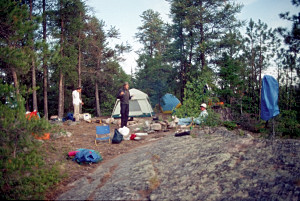 There were two fire rings and two fairly level spots where we could locate the tents. However, the thin soil provided no anchor for tent stakes, and Walter and Rob were forced to tie the Octadome to rocks in some places.
There were two fire rings and two fairly level spots where we could locate the tents. However, the thin soil provided no anchor for tent stakes, and Walter and Rob were forced to tie the Octadome to rocks in some places.
The wind that had attended us all day became sporadic now, and during lulls in the breeze we were beset by hordes of voracious black flies. It was still a bit early for dinner; so Rob and I paddled the Tripper back to the foot of the last rapids to go fishing. While I maneuvered the canoe to maintain good fishing position, Rob cast and trolled his Arkansas Rattletrap lure across the swirling current. Within about 10 minutes he caught a 3 pound pike. Unable to free the lure, he pulled the pike into the canoe, where I tried to hold it down between the paddle and my foot. The fish was very slippery almost slimy to the touch and kept squirting away from us in the bottom of the canoe. As we wrestled with the pike, its blood spread across the floor of the canoe and its strong odor began to permeate everything. Meanwhile the black flies were having a field day as our hands were tied up in the struggle. We finally gave up trying to retrieve the lure. Rob cut the line, leaving the lure hooked to the pike, then put the pike on a stringer and tossed it overboard, resolving to "perform surgery" back at camp. With other lures, Rob fished for another 45 minutes, without success, and then we returned to camp.
Back at camp, Happy Hour was in progress. Walter and Taylor had retreated to the Overlander and fumigated it with PIC while they were still in it -- not recommended, since any airborne substance that kills mosquitoes tends also to be bad for human lungs. They took little notice of the PIC fumes, though, because they were already pickled on bourbon, scotch, and cognac. Doug had taken a full scale bath/swim in the cold lake water and then donned his black mesh shirt, a new piece of equipment he was trying out on this trip. [Whenever he put on this "net suit", Rob referred to him as Netman crusader for truth, justice, and freedom from bugs!] He was now hunkered down in his camp chair, his hands in his pockets and his net suit so completely covered with black flies that he resembled one of the victims in the movie "Killer Bees". 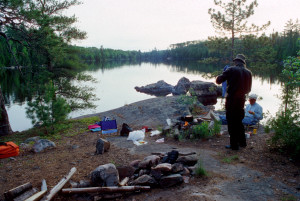 When Rob announced his intention to join the Happy Hour festivities, Doug elected to accompany him into the safety of the tent. They brushed each other free of flies about 20 feet from the tent, then ran like scared rabbits into the tent while Walter and Taylor deftly opened and closed the tent flap to admit them.
When Rob announced his intention to join the Happy Hour festivities, Doug elected to accompany him into the safety of the tent. They brushed each other free of flies about 20 feet from the tent, then ran like scared rabbits into the tent while Walter and Taylor deftly opened and closed the tent flap to admit them.
For reasons which I didn't really understand, the black flies were not bothering me much; so I decided to stay outside and start a fire. After gathering some tender, I removed my headnet (to avoid setting it afire) and discovered to my amazement that no bugs attacked. I went ahead and started the fire, positioned the grill, fetched water to boil, and proceeded with dinner preparations. Still no bug attack. I invited the gang to come out and enjoy the bug free conditions, but they all clung to the tent, convinced that I was trying to set them up for the big FFF (Fly Feeding Frenzy). I ended up eating dinner next to the campfire by myself while the rest of the crew sat in the tent discussing future canoe trips.
After I had eaten in relative peace, the crew ventured out of the tent and cautiously surveyed the area for bushwhacker bugs. Taylor decided to take a chance on a bath before eating dinner. He stripped down and waded into the water up to his knees, then washed off with a washcloth he dipped into the water. The reward for his trouble was a refreshing feeling of cleanliness and an itchy feeling of bug bites on the buttocks. Yes, the black flies had returned! But everyone was hungry enough now to brave any onslaught.
I wanted to take a bath, too, but I was waiting for the right "window of opportunity", that brief transitional period when the temperature had dropped enough to chase away the bugs but not so far as to make bathing a frigid nightmare.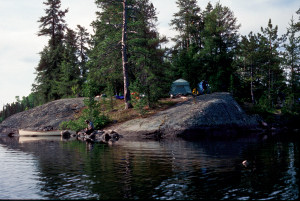 When the window opened, I was through it in a flash: I stripped down, dove in, soaped up, rinsed off, clambered out, dried off, and dressed up in all of five minutes! Despite (or maybe because of) the cold water, I felt great, but my feet had been bruised by the jagged, slippery rocks just offshore.
When the window opened, I was through it in a flash: I stripped down, dove in, soaped up, rinsed off, clambered out, dried off, and dressed up in all of five minutes! Despite (or maybe because of) the cold water, I felt great, but my feet had been bruised by the jagged, slippery rocks just offshore.
We now settled around the campfire for some relaxing conversation in the fading light. It was a splendid, clear dusk, but as the temperature dropped rapidly toward the 40's our thoughts turned to the warmth of our sleeping bags. Most of the crew decided to turn in around 10:30 PM, but I was transfixed by the campfire and lingered for another half hour.
Tuesday, June 23
Mississagi River; running the rapids at portage #14; portage #15; snack on Upper Bark Lake; 500-meter portage #16; Rob pulls the "short sheet" trick on Jim; portage to Bark Lake and Grey Owl's cabin; fabulous campsite at Portage #18.
A loon concert from the southern reaches of the lake roused us all between 5:00 AM and 6:00 AM. Walter started the "Shit Parade" around 5:45. 1 followed at 6:30 and Taylor at 6:45. Mosquitoes were already evident, but black flies waited until sunrise to make their entrance. The sky was no longer clear, but the only clouds were high and sparse. The temperature was just under 500, and there was no wind. I tried to start a fire, but a heavy dew had saturated the available kindling; so Taylor provided a fire starter chip. Since we had used up most of our firewood the night before, I made a trip to the other end of the island to fetch more while Taylor filled the pots with water. We started boiling water as soon as the fire was hot enough.
Doug was up around 7:15, and Walter and Rob emerged from their tent shortly afterwards. Breakfast this morning featured strawberry honey granola. As we ate, a light breeze sprang up from the southeast, but it wasn't strong enough to ward off the increasingly numerous and voracious black flies. Doug broke out a new natural insect repellent called Herbal Green, which he let me try. It smelled nice, but it turned out to be less effective than Muskol.
We decided to break camp early to escape the little beasties. As we took down the tent and packed up, I began to feel a bit queasy. For a while I thought it might be some peculiar reaction to the Herbal Green, but then I recognized the symptoms and timing of the migraine headaches I seem to get about every 10 15 days. I had fallen prey to one of these headaches on the White River trip, and it had ruined most of a day of canoeing. I hoped that a similar fate was not in store for me today.
During our preparations for departure, we noticed that the Tripper, which was out in the river but tethered to a bush next to the water, would occasionally move upstream against the current, seemingly of its own accord. This mystery was quickly solved. Overnight Rob had left his pike on the stringer attached to the canoe. Evidently the fish was still energetic enough to drag the canoe around. When Rob checked the stringer, the pike thrashed about angrily. As Rob observed, "Mr. Pike is not a happy camper this morning." Eventually Rob pulled Mr. Pike up on shore and surgically removed the offending lure. The lure went back into Rob's tackle box, and Mr. Pike went back into the river, his hide and his pride wounded, but not badly enough to keep him out of commission for long.
We finished breaking camp by 9:45AM,our earliest departure yet! The weather continued to surpass our best hopes as we paddled south through Kettle Lake. We followed the west shore, passing between it and a large wooded island, and at last entered the Mississagi River. From this point on it would sometimes be difficult to distinguish between the river and the often narrow lakes it linked.
Soon we reached Portage #14, a 60 meter trail on the right around some rapids. We decided to run the rapids with fully loaded canoes.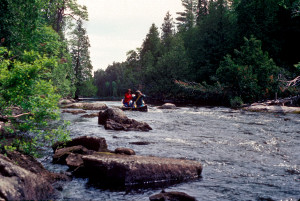 At the beginning of the run we had to pass between a pillow on the left and a large boulder on the right. The trick then was to follow the big water around to the right, passing just left of another large boulder, but avoiding a minefield of submerged rocks on the left. Walter and I took the Tripper through without incident, but Taylor and Doug were swept to the left and got hung up on the submerged rocks near the end of the run. They managed to extricate themselves in short order, though, and soon rejoined us.
At the beginning of the run we had to pass between a pillow on the left and a large boulder on the right. The trick then was to follow the big water around to the right, passing just left of another large boulder, but avoiding a minefield of submerged rocks on the left. Walter and I took the Tripper through without incident, but Taylor and Doug were swept to the left and got hung up on the submerged rocks near the end of the run. They managed to extricate themselves in short order, though, and soon rejoined us.
Portage #15 was already visible from this point. The 20 meter portage trail crossed a peninsula formed by a shallow bay on the left and rock strewn rapids on the right that curved around to the left. We 2 man carried the canoes over the peninsula, then paused to take photographs at the mouth of the rapids. This pause had to be brief, though, for both the flies and mosquitoes were almost unbearable here.
Soon afterwards the river opened up into Upper Bark Lake. It was about 11:30 AM; so we decided to move out to the breezy middle of the lake and start on our snack for the day: dried blueberries, salted pecans, granola bar, and a party mix concoction with dried peas and peanuts. After only a couple handfuls, though, I felt a wave of headache, nausea, and dizziness. So much for the snack.
Once under way again, we noticed that the southeasterly wind had picked up and the high clouds had multiplied enough to counter the warm sun. As we continued south on Upper Bark Lake, I began to feel dizzy enough that I was afraid I might keel over out of the canoe. We decided to pull over to a rocky outcropping on the southeast shore of the lake so that Rob could take over paddling in the bow of the Tripper. For most of the rest of the day, Rob paddled while I sat in the middle of the Tripper trying to weather the migraine.
Our course took us south and then east on Upper Bark Lake, then south again through a long narrows toward Bark Lake. The scenery along this stretch was in some places breathtaking, with massive rocky cliffs rising above the shores. Unfortunately I missed much of this spectacle as I sank into a kind of uneasy slumber interrupted from time to time by sudden temperature changes. (Whenever the clouds moved in front of the sun and the wind picked up, I felt cold. But as soon as the sun emerged and the wind died down, I felt uncomfortably warm.]
Eventually we came to Portage #16, a 500 meter trail from Upper Bark Lake to a small, unnamed lake. The crew would not let me carry much of the load on this portage, and as a result, turned the portage into an arduous enterprise. Walter carried the Tripper, Taylor the Explorer, and Doug Hellpack the entire 500 meters without relief.
At the end of the trail my misery was compounded by an untimely "call of the wild". Taylor and Doug had already loaded my pack into the Explorer and shoved off; so I had no access to my own paper. It was the perfect setup for Rob to pull the old "short sheet" trick. He "generously" offered me a roll he happened to have available, which I gratefully accepted. It wasn't until I had wandered off into the bug infested woods and left my deposit that I discovered that the roll was a mere 2 3 panels woefully inadequate to the task at hand. I had to waddle back to the end of the portage trail, looking somewhat like Grandpappy Amos, to ask for a more humane loan from Walter, then waddle back out in the woods to finish what I had started. If I hadn't felt so crummy, I could easily have strangled Rob! [Note: The preceding paragraph has been edited by Euphemisms Incorporated, a wholly owned subsidiary of the Falwell Ministries.]
On the other side of the small lake we reached Portage #17, a 100 meter trail to the northwest extension of Bark Lake. 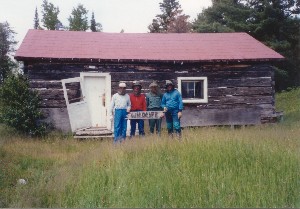 At the end of this trail we encountered a group of crude buildings that once served as the base for the Mississagi Forest Reserve. On one of these structures was supposedly carved the initials of the famous conservationist and outdoor writer Grey Owl. [We had to look for the initials "A.B.", for Archie Belaney, since "Grey Owl" was only the Ojibway name he later adopted as his nom de plume. Doug managed to find and photograph his faint initials.] On the exterior back wall of this weathered grey cabin, someone had hung a variety of rusty old implements. The front door was practically off its hinges, and inside were some beds and small tables. The surrounding smaller buildings had been painted a garish pink color. [One of these buildings was an outhouse, much to my consternation!] Scattered among the buildings were a myriad wildflowers, primarily wild daisies and orange hawkweed. At water's edge, anchored to the shore by a concrete abutment, was an old but solid wooden dock from which we were able to launch the canoes.
At the end of this trail we encountered a group of crude buildings that once served as the base for the Mississagi Forest Reserve. On one of these structures was supposedly carved the initials of the famous conservationist and outdoor writer Grey Owl. [We had to look for the initials "A.B.", for Archie Belaney, since "Grey Owl" was only the Ojibway name he later adopted as his nom de plume. Doug managed to find and photograph his faint initials.] On the exterior back wall of this weathered grey cabin, someone had hung a variety of rusty old implements. The front door was practically off its hinges, and inside were some beds and small tables. The surrounding smaller buildings had been painted a garish pink color. [One of these buildings was an outhouse, much to my consternation!] Scattered among the buildings were a myriad wildflowers, primarily wild daisies and orange hawkweed. At water's edge, anchored to the shore by a concrete abutment, was an old but solid wooden dock from which we were able to launch the canoes.
We continued in a northwesterly direction, following the Mississagi River away from Bark Lake. Along the way we ran three sets of minor rapids, which thrilled Rob no end. [He seemed to be having as much fun canoeing as he would otherwise have had fishing.] Beaver lodges kept appearing on either shore, but we observed no beavers. At some point in the afternoon we paused for only the second lunch of the trip: chicken salad, crackers, pepperoni, and cheese slices. I declined the meal and tried to sink back into my trance like state. But those who indulged were sorry they ate the chicken salad, which reconstituted from a freeze dried mix into a bland paste.
As the afternoon wore on, the sky began to look as if rain might finally come. Cumulus clouds were building up to lofty heights, and some of them looked menacingly dark. Rob grew weary of paddling, and at the same time I started to feel better. We decided to switch back to our former positions, docking briefly at a stone landing on the right bank to accomplish the switch. For the rest of the afternoon, Rob tried to catch up on his fishing.
Shortly after the switch, we saw what appeared to be a beaver or otter swimming near the right bank. It dove under the water, though, and did not appear again. Then we encountered an island campsite that seemed worth investigating. Doug was elected to check it out. He returned to report that there was very little level ground for the tents. The time was about 5:30 PM, but no one really wanted to camp yet because the weather was still perfect for canoeing, and we knew that hordes of bugs awaited us wherever we stopped to make camp. We decided to continue at least as far as Portage #18 unless we encountered a really fabulous campsite along the way.
In fact, we found the fabulous campsite at Portage #18. The portage was a 100 meter trail on the left around some rapids with an impressive two meter vertical drop. The river at this point curved around to the left in a small "S" followed by a large "C". A small stream flowed from the right bank at the top of the "S", around a small wooded island, back into the middle of the "C". At the head of the trail was a campsite sheltered by a dense grove of white cedars. At the end of the trail was a more open campsite with several fire rings and piles of seasoned firewood. The surface of the site was mostly granite, but several large, level patches of moss and lichens suggested decent tent sites. The granite sloped gently into a pool just below the rapids a promising spot for fishing and there were dozens of places to access running water. Finally, a soft breeze from the southeast helped diminish the airborne bug population.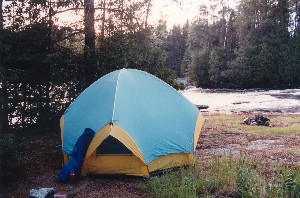 We could hardly have imagined a better campsite!
We could hardly have imagined a better campsite!
After portaging the canoes and gear, we quickly set up camp and began dinner preparations. Doug and I started the fire while Taylor fetched water. Rob tried to snag some fish for dinner but succeeded only in losing two lures on a rocky shelf out in the pool. Dinner consisted of Primavera Alfredo, peas & onions, and raspberry cobbler. The Primavera proved as popular as Honey Lime Chicken. Even I was able to enjoy the meal. By now my illness had faded, and my appetite had returned with a vengeance.
After dinner, Taylor and Rob took some benadryl tablets to relieve the itching from their bug bites. Then they joined us around the campfire to wait for the drowsy side effects to kick in. The side effects were no doubt enhanced by the Jim Beam, Courvoisier, and Bailey's Irish cream that flowed freely for the next hour. The sky began to clear, and it soon became evident there would be no rain after all. Except for the persistent bugs, we had another perfect evening in store. Conversation turned to the possibilities and logistics of a trip on the Missinaibi, which we hoped to do two years later. At around 10:30, Doug succumbed to the fatigue of a long day's paddle (probably a good 20 miles) and retired to the tent. By this time the temperature had dropped enough to chase the bugs away; so the rest of us lingered around the campfire until almost midnight, with Taylor and Rob somehow managing to stay awake in spite of the booze and benadryl. Finally we all crept into our respective tents and quickly fell asleep to the dull roar of the nearby rapids.
Wednesday, June 24
Leisurely morning; running the rapids at portages 19A, 19B, and 20; running Split Rock Rapids; we take aboard a smelly moose skull with antlers; Hellsgate Rapids and the buggy portage around it; portage #23; running the rapids at portage #24; portage #25 around three sets of rapids; we run the second and third rapids; camp below the rapids; evidence of regular hunter use; extensive and disconcerting clearcut; pleasant eventing.
Because of our long day Tuesday, we all slept a bit late Wednesday morning. When Taylor and Doug roused themselves shortly after 8:00 AM, the temperature was around 50°. The sky had a mottled cloud cover, but there was no indication of rain, nor was there any wind. The Overlander was surrounded by hungry mosquitoes, and every attempt to enter or exit brought in a cloud of them which had to be dispatched as quickly as possible. At my request, Doug kindly brought me the log (from my camera bag outside) so that I could work on it without leaving the tent. I remained there for about an hour until the rapidly rising temperature made it uncomfortably warm. Meanwhile Walter and Rob got up, and Taylor and Doug started the breakfast preparations.
Breakfast featured Granopple, which turned out to be everyone's favorite cereal. By the time we finished breakfast, the temperature had risen to about 70°, but to everyone's amazement, there were no black flies. A slight breeze had sprung up, but not strong enough to keep the little beasties away. We speculated that perhaps black fly season had at last ended, although it was hard to believe the end could have come so suddenly. 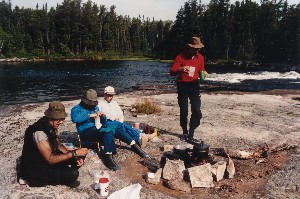 Meanwhile the mosquitoes had retreated from the hot sun, leaving us completely bug free.
Meanwhile the mosquitoes had retreated from the hot sun, leaving us completely bug free.
By 11:00 AM we were still lingering around camp, unable to part with these lovely conditions. I decided to take a bath/swim, this time at a more leisurely pace. The area just below the rapids made an excellent swimming pool, with none of the jagged, slippery rocks of the previous campsite. The water was cold, but very refreshing, and when I climbed back out onto the stone beach, I was able to bask in the sun without fear of being eaten alive. Walter and Taylor washed up a bit, too, but without using my total immersion technique. Rob decided to wade out into the pool to fish for a while, but lost another lure on the same shelf.
After 11:30 the black flies began to reappear as the sun faded in and out behind mounting cumulus clouds. Why the beasties had stayed away for most of the morning remained a mystery, but now that they were back, it was time to get serious about breaking camp. By this time we had become pretty efficient in setting up and taking down our camps; so we were ready to go by noon. Not far downstream we encountered a runnable set of rapids at Portage #19A. There were substantial pillows in the churning water and a haystack at the end; so we elected to portage the gear down a 70 meter trail on the left, then run the rapids in empty canoes. The run went smoothly, but both canoes took in a lot of water in a souse hole near the haystack.
We followed a similar strategy at Portage #19B. After portaging most of the gear down a 60 meter trail on the left, we prepared to run the rapids. Rob decided to join Taylor and Doug in the Explorer. At this point the river swept through a tight "S", with a boulder in the center at the top of the "S", a pillow on the left and boulder on the right halfway through the "S", and boulders on both left and right at the bottom of the "S". The trick was to pass just to the right of the first boulder, pass between the pillow and the second boulder, and then follow the big water between the last two boulders. Walter and I took the Tripper through without incident. 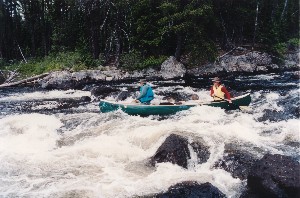 Taylor and Doug started out a bit too close to the boulder at the top, got hung up briefly on the pillow in the middle, then scraped against the right boulder at the bottom. Even so, they had as much fun as we did (although Rob appeared to be somewhat flustered about the close calls). After that we paused for a snack.
Taylor and Doug started out a bit too close to the boulder at the top, got hung up briefly on the pillow in the middle, then scraped against the right boulder at the bottom. Even so, they had as much fun as we did (although Rob appeared to be somewhat flustered about the close calls). After that we paused for a snack.
Portage #20 was only a few hundred meters downstream, and we could already hear the powerful rush of water through a small gorge. Once again, we portaged the gear down a 160 meter trail, then prepared to run the rapids in empty canoes. Rob elected to return to the Tripper for this run. The run looked pretty straightforward. The river curved slightly to the left, with a succession of small challenges: one set of rapids between two boulders; a riffle between a pillow on the left and a boulder on the right; another set of rapids with bigger water, including a haystack on the right; and a pillow on the left at the end. Both canoes made the run with little trouble, although the big water near the end occasioned a bit of bailing after the run.
The next portage (#21) passed around Split Rock Rapids, where the river rushed through a narrow gorge. Except for the namesake large boulder in the center and a shallow, rocky area on the left at the start, the rapids looked easily runnable in fully loaded canoes. In fact, passage looked pretty safe on either side of the boulder; so when we went first in the Tripper, Walter waited till the last second to commit, finally steering the Tripper to the left side. The strong current then pulled us past the boulder without incident.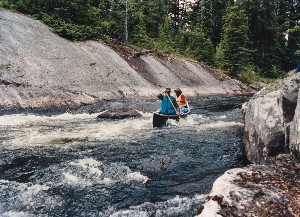 But from the vantage point of the Explorer back upstream, it looked to Taylor and Doug as if we were about to hit the boulder broadside, which would have wrapped Walter and me around its sides and pasted Rob right in the middle. They promptly renamed the rock "Split Rob Rock". Then they followed us past its left side.
But from the vantage point of the Explorer back upstream, it looked to Taylor and Doug as if we were about to hit the boulder broadside, which would have wrapped Walter and me around its sides and pasted Rob right in the middle. They promptly renamed the rock "Split Rob Rock". Then they followed us past its left side.
Just downstream from Split Rob Rock, Doug spotted some moose antlers in the water next to the left bank. On further investigation we discovered that the antlers were attached to a complete skull. However, there were no other parts to the moose skeleton. We speculated that a poacher, after shooting the moose, might have cut off the head (whose antlers would be rather difficult to hide) and taken the body elsewhere to prepare moose steaks. The skull had obviously been in the water for a while -- the antlers were tinged with green -- but not long enough to wash away the smell of decayed flesh. Notwithstanding the odor, Doug decided that he just had to have this "trophy"; so he hauled it on board the Explorer, much to Taylor's chagrin, and balanced it on the packs in the center.
We continued downriver, heading more or less southwest into the wind, until Taylor abruptly moaned that he couldn't stand the smell any longer. Up to this point, he had spent most of the trip in the stern of his canoe so that he could serve as pilot. Now, at his insistence, he and Doug pulled over to the right bank and switched positions, putting Taylor in the bow upwind of the moose and Doug in the stern.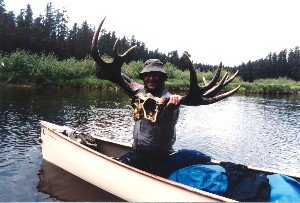 From this point on, position in the Explorer would be determined largely by the direction of the wind!
From this point on, position in the Explorer would be determined largely by the direction of the wind!
During this pause, we noticed that the sky had clouded over completely, and mosquitoes had begun to swarm in increasing numbers. We hurriedly got under way again and approached Portage #22, a 680 meter portage around Hellsgate Rapids. These rapids were situated in an impressive gorge and featured a 10 meter falls. In portaging the canoes and gear, we came upon a wooden stand on which was mounted a small box. In the box Walter found a decrepit registration book next to a nasty, unidentifiable glob covered with ants. He went ahead and recorded our passage, but noticed that few others had done so. In the previous entry, dated June 5, 1992, a group of four noted that they were "one gallon donors" to the mosquito cause. There were no other 1992 entries. After completing the portage, we explored the edge of the gorge, bushwhacking through mosquito infested stands of white cedar and working ourselves into precarious positions on the slippery rocks to take photographs through the mist welling up from the falls.
The mosquitoes were so numerous and persistent here that Taylor and Doug decided to load up and move on before Walter and I were finished photographing the falls. When I finally returned to the end of the portage trail, Rob had loaded the Tripper and was waiting impatiently to push on. There was no sign of Walter, and the mosquitoes were attacking relentlessly. We decided to launch the canoe and wait for Walter out in midstream. After another ten minutes, Walter finally appeared, and we paddled back over to the portage landing to pick him up.
We soon caught up with Taylor and Doug, who had paused for a snack just above the next set of rapids at Portage #23. Here, after a sharp bend to the right, the river passed through a long, straight set of rapids. The top of the rapids looked easily runnable, but the downstream portion was littered with rocks and pillows. We elected to portage the 180 meter trail on the right, which rose steeply through jumbles of rocks, worked its way along the jagged edge of a precarious 3 meter drop, then descended just as steeply through another minefield of rocks.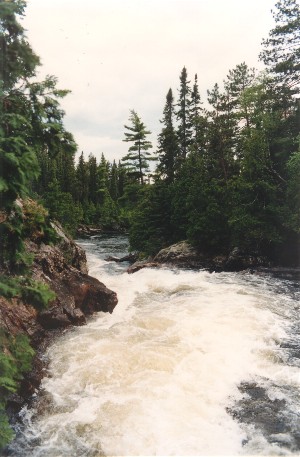 At the end of the trail was a curious sign that read "Caution: Prescribed Burn Area Ahead". At first we thought the sign meant we'd need a burn permit to have a campfire along this stretch of the river. [Where we would get such a permit out here in the middle of nowhere was the source of some puzzlement.] Later we realized the sign was telling us to beware of deliberately set controlled fires whose purpose was probably to clear away combustible materials and stimulate secondary growth in logged over areas.
At the end of the trail was a curious sign that read "Caution: Prescribed Burn Area Ahead". At first we thought the sign meant we'd need a burn permit to have a campfire along this stretch of the river. [Where we would get such a permit out here in the middle of nowhere was the source of some puzzlement.] Later we realized the sign was telling us to beware of deliberately set controlled fires whose purpose was probably to clear away combustible materials and stimulate secondary growth in logged over areas.
We didn't have much time to ponder the sign because the mosquitoes were attacking in droves. We quickly reloaded and launched the canoes and within a few minutes reached Portage #24. Rather than take the 100 meter portage on the left here, we decided to run the rapids fully loaded. We shot straight through some big water between two boulders, sending large standing waves over the bows of the canoes, but neither canoe ran into any problems. Just below the rapids we drifted for a time while we bailed, snacked, filtered water, and fished. Black flies replaced mosquitoes as our chief nemesis here, but there was no place to go for escape, so we just tried to ignore them. The time was just after 6:00 PM, and we became concerned now about finding a decent campsite before long.
We soon encountered Portage #25, a 550 meter trail on the left around three sets of rapids. We decided to portage most of the gear to the end of the trail, then survey the rapids on the return trip to determine whether they were runnable. At the end of the trail, in a grove of Canadian hemlock, we found a campsite that was obviously used on a regular basis by hunters and fisherman. There were the typical rock fire ring, crude plywood table for food preparation, equally crude bench for seating, and a couple of clearings for tents. But away from the main campsite was a rather unusual "park bench" made of roughhewn wooden poles and, in front of it, a second fire ring. One could imagine a honeymooning couple using this bench as a kind of loveseat as they gazed past their own private campfire out into the romantic rapids. The idea of honeymooning hunters seemed rather incongruous, but the evidence was there before us!
Our survey of the rapids revealed that the second and third rapids were runnable, but the first was too much of a rock garden. We portaged the canoes to a point just below the first rapids, then launched for the runs. Walter and I were ready in the Tripper long before Taylor and Doug in the Explorer. Sensing that Taylor was somewhat reluctant to do the run, Walter wanted to wait for them in order to provide moral support. But the black flies were driving me crazy; so I insisted that we go ahead with the initial run without waiting any longer. Rob had declined to join in the fun this time; so we were on our own.
This initial run was somewhat tricky. We had to narrowly skirt a nasty looking pillow on the right in order to avoid a jumble of rocks on the left, but then had to pull hard to the left against the current to avoid a huge souse hole just below the pillow. After a successful run, we paused below the rapids in a somewhat less buggy area to wait for the Explorer. A few minutes later, Taylor and Doug came through the rapids in good form; so we motioned them on to the next set, which they also ran without problems. We then followed closely on their heels. This final set was pretty straightforward. We needed only pass through a distinct "V", then draw left to avoid a large boulder in the center.
We completed the runs just after 7:00 PM. The question now was, "Should we make camp?" The answer was a unanimous "Yes!" After setting up the tents and stringing clothesline to air out clothes and sleeping bags, we began the dinner preparations. 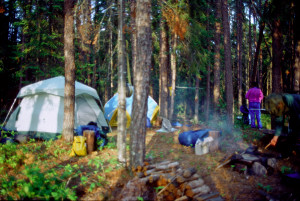 Taylor and I started a fire and set up the grill; then I fetched water from an area just upstream where the current was strong. While we were waiting for the water to boil, Rob, Doug, and I decided to explore a trail that led from the campsite toward the southeast. We soon came upon a decrepit structure of wooden poles and plastic sheeting that looked like some kind of hunting blind. Farther down the trail we emerged into an open, sandy area with a large A frame structure made of logs. This structure appeared to be some kind of rack for preparing slain animals, probably moose (judging from the size of it).
Taylor and I started a fire and set up the grill; then I fetched water from an area just upstream where the current was strong. While we were waiting for the water to boil, Rob, Doug, and I decided to explore a trail that led from the campsite toward the southeast. We soon came upon a decrepit structure of wooden poles and plastic sheeting that looked like some kind of hunting blind. Farther down the trail we emerged into an open, sandy area with a large A frame structure made of logs. This structure appeared to be some kind of rack for preparing slain animals, probably moose (judging from the size of it).
Beyond this clearing was the big surprise, though: clearcut as far as the eye could see! The sandy area with the log structure was adjacent to an ORV track that extended to the north and south along the edge of the clearcut. We followed the track in a northerly direction for a way. Then Doug and I "bushwhacked" away from the road up to a rocky crown to get a more expansive look at the surrounding area. The bushwhacking was easy enough because we encountered nothing more than charred stumps and logs, scattered clumps of scrub, and evenly dispersed waist high Jack pines (apparently planted). From the crown we could see nothing but clearcut at least ten square miles of it and we began to realize with growing horror that the "wilderness" through which we had been canoeing for most of the afternoon was but a narrow swath of woods along the banks of the Mississagi. Feeling rather shaken, we bushwhacked back toward the southwest and rejoined Rob, who had walked back down the road toward the trail from which we had entered this nightmare. When we reported our discovery back at camp, Walter registered no surprise, but simply shrugged his shoulders in disgust. He obviously had no intention of going to look at this eyesore, preferring to enjoy at least the illusion of wilderness.
Our spirits were revived somewhat by a delicious beef stroganoff dinner. The side dishes-mixed vegies and fruit cocktail-were not so well received. For some reason they failed to reconstitute properly and came out "crunchy" and/or "chewy". In fact, a couple of bags of fruit cocktail ended up in the fire, where their contents spewed out like ooze in a horror movie. Most of us ate dinner in headnets because the mosquitoes were innumerable and voracious at this close and breezeless campsite. At least the black flies were gone, though, and the pleasant sound of rapids just upstream helped to sustain a relaxing atmosphere.
After dinner, I walked back up the portage trail in search of a good latrine. There were many fallen trees, their prostrate trunks just the right size and at just the right height to serve my purpose, and their proximity to the river allowed for scenic views of the rapids. This campsite turned out, in fact, to have the best natural latrines of the trip. As I returned to camp, my nose detected Doug's moose skull well before my eyes. Doug had placed it about 30 meters downwind of the camp. By this time we had begun with mock affection to call it Mr. Moose. It was pretty obvious, though, that Mr. Moose would have to clean up his act if he were to accompany us through the rest of the trip.
Back at camp, the crew had settled around the campfire for after dinner conversation and beverages. The sky had cleared up completely, ending the earlier threat of rain, and stars were visible through the sparse canopy of hemlock. As the temperature dropped, the mosquitoes gradually disappeared, and we were at last able to remove our headnets. As usual, conversation turned to recollections of the day's events, expectations for the rest of the trip, and plans for future trips. But at one point we launched into an unusual discussion about jewelry. At around 10:00 PM Doug retired to the tent. The rest of us lingered around the fire for another hour, then retired as well. Once again we fell asleep to the restful sound of nearby rapids.
Thursday, June 25
Packaging Mr. Moose; morning rapids; marsh paddling; encounter with fishermen; the shuffle at "Weasel Rock;" more rapids and marshland; camp on an enormous granite mound; heavy rain storm; peaceful night in the marsh.
The next morning seemed somewhat warmer than usual, with temperature in the mid 50's under a hazy sun. The mosquitoes were up early and ready for breakfast well before we were. Doug exited the tent first at around 6:30AM to "sandblast" and "gift wrap" Mr. Moose. He used sand from the river's edge to scrape off decayed material on the surface of the skull, then wrapped the entire skull and antlers in plastic bags secured with duct tape.
Meanwhile Taylor arose at around 7:00 to go filter water. Rob and I were up around 8:00 and Walter shortly after. When he was done with Mr. Moose, Doug started the breakfast fire. Breakfast had a blueberry theme this morning: blueberry honey granola and blueberry bagels. Blueberry poptarts would have made it a clean sweep, but they were apple cinnamon instead.
While filtering water, Taylor had encountered a spotted grouse on her nest. After breakfast he and Rob returned to the nest to take photos of the grouse and her several chicks. Rob then decided to go fishing for a while just below the rapids. Still no luck. Everyone was relaxed and in good spirits as we began to break camp around 11:00 AM. We were on the river before noon.
Less than a mile downriver we encountered some minor rapids which we ran with ease, although we scraped a couple of pillows and took in a bit of water. Then we came upon a somewhat more challenging set of rapids. At this point the river narrowed just beyond a tiny sand and rock island. The rapids on both sides of the island looked easily runnable, but when the Tripper actually reached the rapids on the left side, we hung up on a rock ledge in very shallow water. Meanwhile Taylor and Doug passed to the right of the island without incident. We couldn't continue forward; so I hopped out of the Tripper, pushed it back enough to free it from the ledge, then hopped back in while Walter paddled furiously in reverse. We then ferried back over to the right of the island and followed the course just taken by the Explorer. As we passed by the island, we noticed that we were just barely clearing another rock ledge that extended out from the right bank.
From this point the river became increasingly marshy.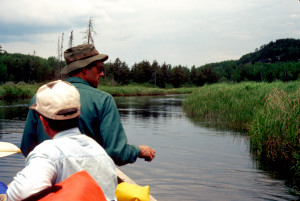 At water's edge the sandy or mucky banks were covered with marsh scrub punctuated by an occasional wild rosebush. Set back from the water were stands of black spruce and red pine that all seemed about the same height evidence of logging or forest fire. Still farther back were rocky bluffs. Along the way we spotted an occasional beaver lodge but saw no beavers. We also saw several campsites, which announced themselves with crude racks of rough hewn poles. As the afternoon wore on, the sky began to cloud over with large, heavy looking cumulus, and the air began to feel more humid. Rain seemed almost inevitable before day's end.
At water's edge the sandy or mucky banks were covered with marsh scrub punctuated by an occasional wild rosebush. Set back from the water were stands of black spruce and red pine that all seemed about the same height evidence of logging or forest fire. Still farther back were rocky bluffs. Along the way we spotted an occasional beaver lodge but saw no beavers. We also saw several campsites, which announced themselves with crude racks of rough hewn poles. As the afternoon wore on, the sky began to cloud over with large, heavy looking cumulus, and the air began to feel more humid. Rain seemed almost inevitable before day's end.
Rob tried fishing in the relatively shallow, weedy water, and whenever he hit a snag, we would drift and snack for a while. During one of these drifting spells, Rob hooked a 2 3 pound pike, but just as he pulled the fish up to the canoe, it broke the line and absconded with the lure, much to Rob's dismay.
From time to time we came upon families of ducks, typically a mother and 6 10 ducklings. With each encounter we observed the same pattern. The mother would begin thrashing about in the water, trying to be as conspicuous as possible. Meanwhile, the ducklings would scoot over to the weedy, brushy shoreline, or in some cases dive under the water, in an effort to become as inconspicuous as possible. Still thrashing about, the mother would "lead" us downriver away from the ducklings and, when the distance seemed safe, would suddenly take off, flying over to one bank or the other, then circling back to the ducklings via an obscure route behind bushes or trees near the river. We marveled at the consistency of this "strategy" from one duck family to the next. The behavior had to be largely a matter of instinct, yet it was hard to imagine that such complex behavior could be inherited.
We began to encounter more and more oxbow lakes, and eventually it became hard to distinguish between the river and the lakes or to tell where the river was going.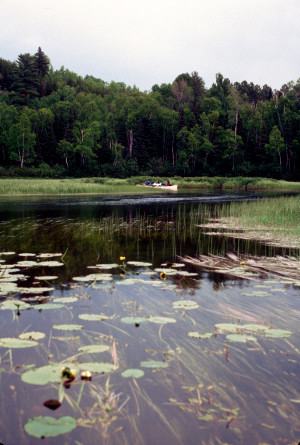 In some cases we would cut across stretches of shallow water thick with reeds in order to ply a straighter course than the winding river. The canoes began to feel like airboats in the everglades and, at times, like frigates trapped in the Sargasso Sea. In some instances we had to power the canoes up to "ramming speed" to get through walls of reeds. Eventually we left this broad marsh and resumed our course along the still winding but more distinct river, its course now defined by high, sandy banks. At around 2:30 PM we came upon a couple of fishermen in a small boat. They advised us to watch out for rapids near the "Y" where the Abinette River flowed into the Mississagi. They claimed they had had to turn back at that point because their boat could not negotiate the rock strewn waters. Walter was skeptical about this advice because there was no indication of such rapids on the topographical map. We pressed on and tried to ignore the fishermen.
In some cases we would cut across stretches of shallow water thick with reeds in order to ply a straighter course than the winding river. The canoes began to feel like airboats in the everglades and, at times, like frigates trapped in the Sargasso Sea. In some instances we had to power the canoes up to "ramming speed" to get through walls of reeds. Eventually we left this broad marsh and resumed our course along the still winding but more distinct river, its course now defined by high, sandy banks. At around 2:30 PM we came upon a couple of fishermen in a small boat. They advised us to watch out for rapids near the "Y" where the Abinette River flowed into the Mississagi. They claimed they had had to turn back at that point because their boat could not negotiate the rock strewn waters. Walter was skeptical about this advice because there was no indication of such rapids on the topographical map. We pressed on and tried to ignore the fishermen.
Half an hour later, though, the same two fishermen came up from behind us, their boat powered by a slow, noisy, smelly motor. They were chattering away in what sounded like Spanish but may have been a warped form of Canadian French. They were also drinking bottles of beer and acting a little drunk. Fortunately they passed us without incident and eventually moved out of earshot. But we were concerned that they would scare away any wildlife we might otherwise see on this stretch of the river.
Before long we reached the confluence of the Mississagi and Abinette. Walter's skepticism was vindicated: there were no signs of any rapids. We decided to stop here to eat lunch, to let Rob fish, and to allow the fishing boat to move well down river so that we wouldn't see it again. (In reality, the fishermen had stopped at their campsite, which, as we discovered when we passed some time later, was perched high on a rocky bluff on the right side of the river.] Our lunch only the third one of the trip consisted of peanut butter and crackers, beef jerky (which I traded to Rob for a chocolate survival bar), and fruit'n'nut pemmican.
Shortly after lunch a light rain began to fall. Although it subsided after a few minutes, we knew we were in for more because the sky was so heavily laden with dark clouds. At this point my rain gear was in the other canoe, and Taylor's rain gear was in our canoe. Meanwhile, Taylor was complaining of a sore shoulder. We decided to stop in order to reshuffle gear and crew. We docked both canoes at a large, oblong rock in the river, then executed a slightly obscene version of a Chinese fire drill:
. Taylor fetched his rain gear from the Tripper;
. I move my rain gear from the Explorer to the Tripper;
. Taylor replaced Rob in the middle of the Tripper;
. Rob replaced Walter in the stern of the Tripper;
. Walter replaced Taylor in the bow of the Explorer;
. Most of the crew relieved themselves into the river.
Almost immediately this multipurpose rock became known as "Weasel Rock".
Not far downstream from Weasel Rock we came to rapids with no evident portage trail around them. Apparently these were the rapids the two fishermen had warned us about just in the wrong place. Doug and Walter were well ahead of us and took the Explorer through the rapids with scarcely a pause. Rob and I were preparing to take the same course with the Tripper when Walter hopped out of the Explorer, scrambled up on a jumble of rocks on the right bank, and motioned for us to back off. We quickly pulled over to the left bank, where Taylor grabbed the tip of a strainer to hold us in position against the current. Walter then motioned for us to bring the Tripper over to the rocks where he was standing. With Taylor shouting back ferry instructions from the middle of the canoe, Rob and I back paddled furiously and without much coordination, then veered over to the rocks. There Walter informed us that the run would be more tricky than it appeared. The left side of the river was too shallow for passage, all the way out to a large boulder in the center. The right bank was guarded by the rocks on which Walter was now standing. What looked like a clear passage between the boulder and the rocks actually contained a menacing pillow. He recommended that we back ferry to line up the canoe, then shoot the narrow passage just to the left of the pillow, i.e. between it and the boulder.
Once again we back paddled furiously while Taylor shouted instructions, but instead of lining up the canoe, we careened wildly over to the left bank, where Taylor again grabbed the strainer. Again we launched in an effort to line up the canoe, but this time, while I back paddled in the ferrying effort, Rob paddled forward in an exasperated attempt to get the run over with. The result was that the canoe headed straight for the pillow we were supposed to avoid. Taylor screamed for me to paddle forward as his life flashed before his eyes. Walter shouted from the rocks that we weren't lined up properly to make it safely left of the pillow. I started to paddle forward but then reflexively drew right, pulling the canoe to the right of the pillow, between it and the rocks. A loud scraping noise told us we were tempting fate, but the canoe passed through OK exactly where we would have gone if we had not stopped!
After this excitement, we were ready for more relaxed canoeing. Walter had taken his map with him to the bow of the Explorer and was looking for a "northwest passage" that the map indicated would save us almost two miles of canoeing. Somehow we missed the turn off, though, and ended up paddling the extra distance along broad loops of the river through very marshy terrain. At one point we came to rapids, again with no evident portage alternative. We ran them straight through but scraped a pillow in the big water at the end.
We resumed our course, but were having considerable trouble keeping up with the Explorer. Rob attributed the problem to Walter's rapid strokes, which allegedly were a deliberate attempt to leave us behind. I suggested to Rob that we change places to take advantage of my J stroke versus his constant ruddering. We pulled over to the bank, made the switch, and were subsequently able to maintain a decent pace. But Rob continued to take Walter to task for paddling too fast.
Not long after the switch, we came upon the end of the northwest passage we had missed earlier. We were now well into an area known as Majestic Marsh. The time was approaching 6:30 PM. Although we hadn't had more than a few sprinkles up to this point, massive clouds and curtains of rain in the distance in practically every direction suggested that we would soon encounter drenching rain. We began looking in earnest for possible campsites.
Since we were in marshy terrain, we wanted a campsite up on a bluff, if possible, to provide some relief from the bugs. After rejecting a couple of such sites as too difficult to reach from the water, we spotted an enormous hunk of granite set back from the left bank of the river but accessible through a pond that was connected to the river by a narrow, shallow channel. We powered the canoes through the channel and landed on the pond's muddy shore, then conducted a cursory investigation of this mound of rock. Walter voted to make camp here, but most of the crew thought we could do better farther downstream. As we were debating the matter, a brilliant flash and loud thunderclap settled the issue.
We scrambled to get the gear up the steep, slippery rock face. The most direct route from the canoe landing was simply impossible to climb; but Walter discovered an alternative route that involved climbing up between some jagged rocks and working our way around a couple of stunted black spruce trees. We found that the easiest way to get the gear up to the site via this route was to pass it along in the style of a bucket brigade.
From the top of the rock we had an impressive 270 degree view of the river and the surrounding marsh. Behind us the rock was absorbed into a dense stand of black spruce.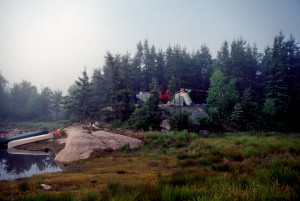 There wasn't much level surface, but a carpet of moss and lichens on the pond side of the rock made a reasonable site for my tent, and the bare side away from the pond made an acceptable site for the kitchen. Walter ended up having to site his tent back in the woods in an area that had to be cleared of dead spruce and other debris. Amazingly, we were able to set up the tents, chop firewood, build a fire ring, string up a tarp above the fire ring, and start a fire all before the storm actually hit us. In fact, the storm held off until Walter and Doug ventured out in the Tripper to filter water in the river. Then the bottom dropped out, and we were pelted by a wind-driven deluge for almost half an hour. Taylor, Rob, and I managed to keep fairly dry under the suspended tarp, even though it was flapping wildly in the wind, but we were starting to feel pretty cold. Matters were much worse out in the canoe, where Walter and Doug were getting drenched in spite of their raingear. Nevertheless, by using both Walter's and Taylor's filters, they managed to fill all our drinking water canisters and canteens and to prepare enough water for dinner that night and breakfast next morning.
There wasn't much level surface, but a carpet of moss and lichens on the pond side of the rock made a reasonable site for my tent, and the bare side away from the pond made an acceptable site for the kitchen. Walter ended up having to site his tent back in the woods in an area that had to be cleared of dead spruce and other debris. Amazingly, we were able to set up the tents, chop firewood, build a fire ring, string up a tarp above the fire ring, and start a fire all before the storm actually hit us. In fact, the storm held off until Walter and Doug ventured out in the Tripper to filter water in the river. Then the bottom dropped out, and we were pelted by a wind-driven deluge for almost half an hour. Taylor, Rob, and I managed to keep fairly dry under the suspended tarp, even though it was flapping wildly in the wind, but we were starting to feel pretty cold. Matters were much worse out in the canoe, where Walter and Doug were getting drenched in spite of their raingear. Nevertheless, by using both Walter's and Taylor's filters, they managed to fill all our drinking water canisters and canteens and to prepare enough water for dinner that night and breakfast next morning.
Shortly after Doug and Walter returned, the storm subsided, and we were able to fix and eat dinner in relative peace. Dinner consisted of Wildtyme Turkey Casserole, Corn, and Peach Cobbler. Since I don't like turkey, Doug had packaged a special Tuna Noodle Casserole for me and, to make the portions come out right, had mixed the spare part of this casserole with his own helping of turkey casserole. He ended up trading this mixture to Rob for the plain turkey casserole. While we ate, we were somewhat surprised to see only a smattering of mosquitoes in these damp conditions. We speculated that the storm might have dropped the temperature too much for them.
After dinner, Doug, Taylor, and I evaluated the storm's effect on my tent. The floor of the tent was completely saturated, and it looked as if we would have a rather unpleasant sleep that night. But Doug suggested that we take the polyethylene tarp out from under the tent, wipe it off, and put it inside the tent. At first Taylor and I objected that this would leave the floor of the tent unprotected. But when we lifted the tent and tarp, we discovered that the moss and lichens underneath were still dry and then realized that this dry, cushiony underlayment posed no threat to the tent floor. We followed Doug's suggestion and were completely satisfied with the results. I resolved then and there to get another tarp for the inside of the tent as soon as we returned home.
As the evening wound down, the sky began to clear, and the threat of further rain diminished, much to our surprise (we had assumed it would rain all night). We gathered around the campfire for after dinner aperitifs and some conversation about woefully inadequate raingear (Walter and I were especially disgusted with our supposedly waterproof outfits). We tried to keep the fire going, but some of the wood was wet from the storm, and as pockets of steam exploded in the wood, we were showered with sparks. Meanwhile, the mosquitoes returned en masse for a late dinner, and we had to don our headnets. After a while, Walter, Rob, and Doug decided to retire for the night. The mosquitoes finally gave up as the food departed, the light faded, and the temperature dropped. Taylor and I were able to shed the headnets and stand on the rock gazing up at rapidly multiplying stars. The silence was broken only by frogs beeping in the marsh and rowdies talking boisterously in the tent back in the woods. Finally fatigue overcame us, and we too retired to the tent.
Friday, June 26
Morning fog; clothesline struggle; "Home on the Rock;" scenery in the vicinity of Majestic Marsh; Rocky Island Lake; campsite on the lake; a refreshing swim; evening storm.
In the morning we awoke to a cold, silvery mist hovering over the marsh. The sun was just barely visible through the mist, and everything was wet. Taylor got up before 7:00 AM to start the fire. Doug and I got up about half an hour later to take down the tarp over the kitchen. 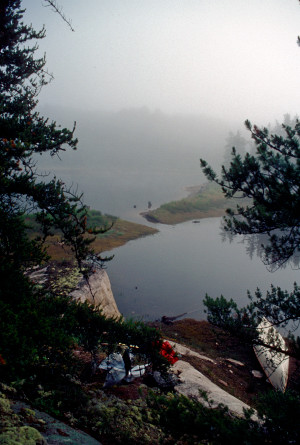 The rope that had suspended the tarp was then converted to clothesline for drying out our clothes and sleeping gear. While we were straining to fasten the clothesline to trees at the edge of the rock, Doug slipped down the treacherous stone slope and wrenched his knee. To avoid further mishap, we changed our clothesline hanging strategy. Instead of leaning out over the edge to attach the rope to a branch at the right height, we tied the rope to my knife, tossed the knife over the branch and let it fall to the ground below. Descending from the rock to the base of the tree by a less hazardous route, we then pulled the rope taut from below and anchored it on a lower branch.
The rope that had suspended the tarp was then converted to clothesline for drying out our clothes and sleeping gear. While we were straining to fasten the clothesline to trees at the edge of the rock, Doug slipped down the treacherous stone slope and wrenched his knee. To avoid further mishap, we changed our clothesline hanging strategy. Instead of leaning out over the edge to attach the rope to a branch at the right height, we tied the rope to my knife, tossed the knife over the branch and let it fall to the ground below. Descending from the rock to the base of the tree by a less hazardous route, we then pulled the rope taut from below and anchored it on a lower branch.
During our clothesline struggle, Taylor went down to the canoes to fetch breakfast packets from Hellpack, which we had left down by the pond overnight to ensure that no marauding bear would visit the campsite in search of food. When he returned, he helped me move my tent out to a bare section of the rock, where we tilted it on its side to dry out the floor. We didn't really expect much drying in the misty air, but I didn't want to pack a sopping wet tent in my riverpack, and any drying at all would be an improvement. Surprisingly enough, though, the tent floor would dry almost completely before we broke camp.
Breakfast this morning switched to a strawberry theme: strawberry honey granola and strawberry poptarts. The plain bagels intended for this meal had molded a bit, and some were tossed into the fire. I managed to rescue Walter's bagel before it met that fate and was able to eliminate the moldy taste by judicious toasting.
Just before breakfast, Rob had been singing "Home on the Range" as he puttzed around the tent site back in the woods. At breakfast we came up with a similar song more appropriate to our circumstances:
Home, home on the Rock,
Where canoeists and campers get crocked,
Where seldom is found
A safe way to climb down
Nor a place for canoes to be docked.
Home, home on the bog,
With the loons, the mosquitoes, and frogs,
Where clothes never dry
No matter how hard they try,
And canoeists get lost in the fog.
Later I added another verse:
Home, home on the Rock,
Where a thunderstorm forced us to stop
By a leach 'fested pond
With the marsh just beyond
And a campsite as damp as a mop.
We also had a discussion launched by Doug's question, "Why do we do this [the canoeing/camping expeditions]?" The responses were varied:
Walter: Canoeing/Navigation Challenge, Wilderness
Taylor: Fun, Jovial Fellowship, Canoeing Challenge
Rob: "Larry [Walter] makes me do it", Beauty of Wilderness
Me: Exploration, Fresh Walleye (hint to Rob]
Doug: "All of the above"
We began to break camp at around 9:15 AM, but we were in no great hurry because we knew we wouldn't be able to navigate on Rocky Island Lake (2 3 miles away) while the conditions were so foggy. By 10:00, though, the sun had burnt off the fog, as the temperature gradually rose into the upper 50's, and the mosquitoes and black flies began to show up. We then accelerated our efforts and were ready to launch by 10:30.
The increasingly warm and humid conditions turned Mr. Moose into a less than friendly companion. But this would be our last full day of canoeing, and everyone was in a convivial and somewhat tolerant mood except Rob, who complained that we were stopping too much to take photographs of the varied scenery. 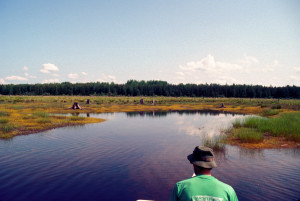 There was, in fact, a lot of scenery to photograph. Along the shores were clumps of blue flag and in the water flotillas of pondlillies with their waxy yellow flowers. Just back from the shore were rank upon rank of stumps that made certain sections of the marsh look like the Arlington National Cemetery of the Logging Industry. [Evidently this area had been clearcut when the decision was made to dam the river to create Rocky Island Lake. Why the area was not now covered with water was a mystery to us.] Away from the river were rocky bluffs and various interesting rock formations.
There was, in fact, a lot of scenery to photograph. Along the shores were clumps of blue flag and in the water flotillas of pondlillies with their waxy yellow flowers. Just back from the shore were rank upon rank of stumps that made certain sections of the marsh look like the Arlington National Cemetery of the Logging Industry. [Evidently this area had been clearcut when the decision was made to dam the river to create Rocky Island Lake. Why the area was not now covered with water was a mystery to us.] Away from the river were rocky bluffs and various interesting rock formations.
Gradually we passed out of Majestic Marsh. Although the riverbanks remained somewhat marshy, the shore was now lined with black spruce, white cedar, and canoe birch, and behind them the bluffs and rock formations became even more interesting. At one point we stopped to take photographs of each canoe in front of a rocky outcrop with two enormous boulders that looked like just rolled dice. While we were posing for the photos, a motorboat with two men passed behind us headed east at high speed, leaving an annoying battery of waves in its wake.
Gradually the "marsh" gave way to Rocky Island Lake. The bright sun was beginning to make us uncomfortably warm; so we removed our shirts and rubbed on some sunscreen. At around 12:30 PM we stopped for a snack in the middle of a broad, shallow expanse of water, no doubt the eastern arm of the lake. Rob fished for a while but was rewarded only with snags. After our snack, Walter and I paddled over to the south shore to relieve ourselves along the bank. In the process, we picked up some nasty sand fly hitchhikers, which followed us back out into the lake, their dive-bombing maneuvers making them sound like Indy race cars.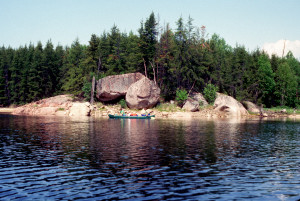 Rob began calling it the "Fly 500". Walter and I put our shirts back on to avoid sunburn, but Rob elected to continue catching the rays, a decision he would pay for later.
Rob began calling it the "Fly 500". Walter and I put our shirts back on to avoid sunburn, but Rob elected to continue catching the rays, a decision he would pay for later.
At around 1:45 PM Doug and Taylor experienced the call of the wild and pulled over to an island that appeared to have a fairly nice campsite. The site was breezy and had easy access to the water, and the presence of the usual fire ring, racks, and table suggested regular use by fishermen. Doug even found an old metal chair, which he carried over to a scenic overlook for a few minutes of relaxation. Meanwhile we drifted out in the lake, giving Rob what turned out to be his last opportunity to fish. He caught nothing. As a result, this trip became the first on which we failed to have at least one fresh fish meal.
As we proceeded down the lake, "bleach bands" 6 8 feet above the water made it increasingly obvious that the water level was way down. We speculated that the unusually fair weather we had experienced so far on the trip might be part of a more extended drought pattern that had forced the authorities to open the dams on the lake.
At around 2:30 PM we paused at a narrow, secluded, and especially scenic bend in the lake to admire a rather attractive campsite. The campsite was on the left and looked out across the lake to an awesome array of woods and rock formations as they ascended the steep slopes of the river valley. We were sorely tempted to camp here, but we were still 4 miles from our take out point. We wanted to camp within 2 miles of the take out so that on Saturday morning we could get an early start for the drive back home. A short time later we encountered an equally appealing campsite on a rocky cliff where the lake narrowed to a mere 20 meters. We began to get the uneasy feeling that, in passing up these great campsites, we were guaranteeing ourselves a real dog of a campsite farther down the lake.
As we moved back out into a more open section of the lake, we encountered two more motorboats. Normally such encounters would be depressing, but the weather was so magnificent that nothing could get us down. The sky was flecked with large, fluffy white cumulus clouds that occasionally passed in front of the sun, dropping the temperature from the low 70's into the mid 60's. A light westerly breeze kept us refreshingly cool but posed no obstacle to our westerly progress. Our only challenge in the Tripper was to stay ahead of the Explorer so that we could remain upwind of Mr. Moose. At one point, Walter and I got into a discussion about Jim Morrison. Rob, who is more of a country music fan, remained uncharacteristically silent, no doubt bored by my feeble attempts to express musically some of my favorite passages from the Doors albums. But he perked up when I tried to sing Garth Brooks's "I Got Friends in Low Places" maybe because he likes Garth Brooks, but probably because the song describes his own circumstances!
By 3:30 we had paddled far enough west to begin looking seriously for a campsite. After passing up a couple of potential sites along the open section of the lake, we reached a narrower finger of the lake down which we could see our final destination, Rouelle Landing. We veered off to the northeast around a large island, but no campsites were evident anywhere. Most spots were low, rocky, and overgrown with stands of birch. At one point we followed a motorboat through a narrow, rocky channel marked with buoys made of plastic laundry detergent bottles. This channel opened into the southern reach of Seven Mile Bay, but there were still no decent prospects. Just as we began to contemplate backtracking to the main body of the lake, Walter spotted a promising point of land off to the west. On closer approach, we found an almost perfect campsite. Rocky banks rose gently to an open, breezy grove of red pines and white cedars with numerous level tentsites carpeted with soft pine needles. There was also a convenient kitchen/dining area with an established fire ring, plenty of cut firewood, and an impressive view of the bay. The only drawback was the presence of a fishing lodge just across the bay on the northwest shore. We quickly unloaded the canoes and set up camp.
Behind the campsite a trail led back into the woods revealing the rough hewn wooden skeleton of what appeared to be a hunting blind. This triangular structure was suspended among three tall pines at a level about 5 meters above the ground and could be reached via two crude "home made" pole ladders, their rungs spaced so far apart as to make climbing very difficult. Several nearby trees had names carved into their trunks in large block letters lined up vertically with almost perfect spacing. It looked as if this work had been done by a professional woodcarver! Just beyond these trees was a makeshift latrine with a real toilet seat. The trail continued back into the woods, which suggested that it might lead all the way to Rouelle Landing. But when I attempted to follow it, I discovered that it pretty much disappeared only 20 meters or so into the woods.
On the west side of the campsite a granite beach veined with quartz sloped gradually into the water, creating a natural "swimming pool" similar to the one we had enjoyed at our Tuesday evening campsite. Amazingly, there were hardly any bugs just a few scattered black flies and sand flies and the warm, sunny conditions enticed the whole crew to go swimming. In rapid succession Rob, Taylor, Doug, and Walter took the plunge while I took photographs of them with their own cameras. By the time I was able to join the fun, everyone had left the water except Doug. The water seemed a bit warmer than on my previous baths/swims, but pockets of frigid water welled up from time to time to remind me that we were still in Canada. In the end, this communal swim lasted less than half an hour, but everyone felt thoroughly refreshed and clean enough for the trip home. In fact, there was some concern that our families would be suspicious if we didn't come home smelling like Mr. Moose. But then we realized that we could always rely on our foul smelling clothes to redeem us.
After the swim we noticed that great dark clouds were moving toward us from the north, even as a light breeze blew steadily from the west.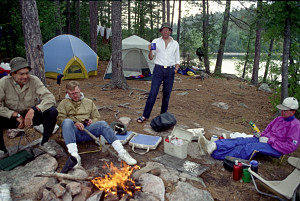 Off to the distant northeast we could see curtains of rain. We decided we'd better have an early dinner and be prepared to retire to the tents in case of rain. I started up a fire, but then we decided to eat from our lunch packets instead of the dinner packets, making it unnecessary to unpack the grill and pots. For "dunch" we had summer sausage, cheese, Tuscany toast, and bagel chips; and for dessert we had chocolate survival bars dipped in peanut butter (a recently discovered delight comparable to Reese's buttercups).
Off to the distant northeast we could see curtains of rain. We decided we'd better have an early dinner and be prepared to retire to the tents in case of rain. I started up a fire, but then we decided to eat from our lunch packets instead of the dinner packets, making it unnecessary to unpack the grill and pots. For "dunch" we had summer sausage, cheese, Tuscany toast, and bagel chips; and for dessert we had chocolate survival bars dipped in peanut butter (a recently discovered delight comparable to Reese's buttercups).
As we sat around the campfire talking about the trip and sipping our various alcoholic beverages, "Louie" of Louie's Fishing Lodge (the one just across the bay) sped up in a motorboat with a young boy in the front. He asked us where we were from, where we had started the trip, and where we were headed, and he confirmed our speculations that the authorities had drastically lowered the level of the lake. We chatted with him for about 10 minutes, long enough to learn that he was originally from Saginaw and had come to this area of Canada 22 years ago. Then he sped away.
By this time the threat of rain was hard to ignore. We left the campfire long enough to pull our stuff off the clotheslines and stash it in the tents or riverpacks. Then we returned to the campfire to hear Walter relate a tale about a "charity" case his law firm had taken in Dayton. It seems that this lesbian truck driver had been fired from her job, and the trucking company had confiscated the contents of her truck, including her personal electric vibrator. She was suing the company to get her belongings back. We all looked at each other in bemusement, then hit on the obvious newspaper headline:
Dateline Dayton:
Despondent Diesel Dyke
Dickers Desperately for
Detained Dildo
Everyone laughed, but Rob and I laughed so hard we almost had a stroke. After that, all I had to say to him was "Dateline Dayton" and we were both rolling on the floor.
Our fun was finally interrupted by the long anticipated thunderstorm, which forced us into the tents at around 8:30 PM. But this early retirement fit well with our plans to rise at 6:30 the next morning. It was still light outside, of course; so for a while we lay in the tents just listening to the storm. Surprisingly, the rain ended only an hour later, and then it became very quiet.
Saturday, June 27
Loading the equipment and Mr. Moose; breakfast at Carolyn Beach; the trip home.
Perhaps because of the quiet, no one slept very well. As dawn approached, the quiet was broken by raucous bird calls and the loud rush of a wind that had suddenly sprung up. Everyone got up earlier than planned about 5:45AM and stumbled out of the tents into cold, wet, windy, overcast weather. It seemed just the right time to be ending our trip. With no plans for breakfast, we were packed and ready to go by 6:30.
We launched the canoes for the last time and reached the vehicles before 7:00. We were amazed at the transformation to Rouelle Landing. When we had left the Probe there the previous Saturday, the place had been completely deserted. Now it looked like a camper's village, with a motor home, several RV's, and a dozen other vehicles parked in the vicinity. In the midst of this assemblage was a pole, about 10 meters tall, from which a large Canadian flag flapped noisily in the breeze. Smoke from a nearby campfire or woodstove rose tentatively into the air, then drifted away at a slant.
As we loaded the vehicles for our departure, a couple of short, squat, beefy fishermen were preparing to launch their motorboat for a day of fishing. They engaged us in idle conversation about the weather and fishing conditions and asked a few questions about our trip. Rob was somewhat interested in their plans to use live bait, but they soon departed for the open lake.
In some respects, loading the vehicles for the return trip was easier than for the trip up. Since we no longer had to do capacity planning for the Aerostar shuttle, we could put a lot of the gear into the Probe. Walter had some trouble remembering how the Tripper had been lashed to the front and rear of the Aerostar, but that matter was soon resolved. The only major challenge was to figure out how to transport Mr. Moose. There was no chance he could ride inside either vehicle: His fellow passengers would pass out from the odor. 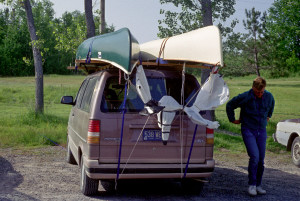 But outside the vehicles he would present problems with wind resistance. Doug finally decided to suspend him between the rear lashings of the two canoes in a kind of spider web of rope sheltered from the Aerostar's slipstream.
But outside the vehicles he would present problems with wind resistance. Doug finally decided to suspend him between the rear lashings of the two canoes in a kind of spider web of rope sheltered from the Aerostar's slipstream.
With the vehicles loaded, we negotiated the ruts and potholes of Peshu Lake Road back to Route 129, then headed south for Thessalon. Initially we had planned to stop for breakfast at the nearby Johnny's Can Op Truck Stop, but then we decided to press on to the Carolyn Beach restaurant where we had so much enjoyed breakfast on the trip up. Rob and I were in the Probe, and as we followed the Aerostar, we noted with some amusement that Mr. Moose looked as if he were about to charge us from the back of the van.
At Carolyn Beach we all tried to call home, but only Doug and Taylor succeeded in talking to their families. Walter got no answer; my line was busy; and Rob had to settle for a message on his answer machine and a call to work. Once again Carolyn Beach provided us with a splendid meal in pleasant surroundings, and then we were on our way.
Taylor had expressed an interest in trying out the Probe, so he took the wheel. At this point the Probe was rather low on fuel, but we took a calculated risk of waiting on the refuel until we reached Sault St. Marie, Michigan, where we expected gas to be much less expensive than in Canada.
We reached Sault St. Marie, Ontario, just before 11:00 AM. We were all concerned that Mr. Moose would have some difficulty getting through U.S. customs. There was no question that we should declare him, but we didn't know how long it would take to clear him. When the Aerostar pulled up to the rightmost tollbooth, Taylor and I pulled into a different lane in the Probe, fully expecting to have to wait for the Aerostar at the customs office just beyond the booths. To our amazement, the Aerostar paused only a moment, then continued without delay. In fact, it was the Probe that was delayed somewhat when our tolltaker turned to stare at Mr. Moose as the Aerostar pulled away from the other booth!
Once past the tollbooth, Taylor raced to catch up with the Aerostar, then pulled ahead so that we would be clearly seen when we exited the freeway moments later to refuel. At the gas station, Walter, Rob, and I were finally able to call home successfully. The cold, overcast conditions we had departed on Rocky Island Lake were now a distant memory. The weather here was sunny and warm, and temperatures climbed as we continued south.
We stopped once more for food and fuel in Birch Run, just north of Flint. The search for food gave rise to a typical squabble. Walter wanted to continue toward home with as little delay as possible; so he favored the nearby McDonald's drive through for a quick burger. Rob wanted to stop at the Tony's Restaurant next to the gas station for a somewhat more leisurely pizza and beer. I was in favor of the pizza, but only because I hate McDonald's food. 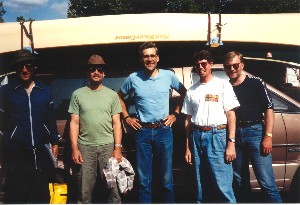 The result was a 3 way split: Walter and Doug went to McDonald's for burgers; Rob went to Tony's for a couple of cold beers; and Taylor and I went to an Arby's just down the road for roast beef sandwiches. Walter was not happy about Rob's cold beers on an empty stomach. He expected Rob to do some of the driving from Brighton down to southern Ohio.
The result was a 3 way split: Walter and Doug went to McDonald's for burgers; Rob went to Tony's for a couple of cold beers; and Taylor and I went to an Arby's just down the road for roast beef sandwiches. Walter was not happy about Rob's cold beers on an empty stomach. He expected Rob to do some of the driving from Brighton down to southern Ohio.
When at last we reached Brighton around 5:30 PM, there was a mad scramble as we transferred the canoes back to their home vehicles, unloaded and redistributed the gear, divided up the remaining food, took appropriate pit stops, and gulped down carrot cake, sweet rolls, coffee, and pop that Emily had assembled.
Once most of the gear was out of the Aerostar, Doug put Mr. Moose in the back seat, opened the windows wide, and departed for home. He later reported that Mr. Moose had taken up residence in his back yard pending the development of an effective moose deodorant. We all hoped that at some future date we would be able to visit Mr. Moose in more honorable and congenial surroundings.
The Taylors departed soon after, the scratched but stalwart Explorer secured to the top of their Acura. And finally Walter and Rob departed in the Toyota van, the aged but tireless Tripper strapped to the roof rack, which appeared secure enough despite the earlier damage to the Toyota's rain guttering.
Post Morten
Of the four wilderness canoe expeditions we've taken, Mississagi was by far the most relaxing and least problematic. In the end, it may be less memorable than the others precisely because it went so smoothly by comparison. On the whole, the successes far outnumbered the failures. But the failures are worth mentioning because they are instructive and because, in any case, they helped define the experience:
. Black Flies: The little critters were far worse than anyone anticipated. We were physically prepared for them about as well as on the Wakami trip, but mentally it was no contest: The flies won in a rout.
. Dark Clothing & Shirts with Button Sleeves: Both the flies and mosquitoes just love them. You'd think we'd have learned the lesson after three previous trips. Next time for sure!
. Bug Dope: Muskol seems to work OK for short periods, but when the bugs are really swarming, nothing works for long. We continue to search for a truly effective repellent.
. Fresh Fish: Oh, for the taste of fresh walleye!
. Wildlife: A moose skull, a couple of grouse, and a handful of loons and ducks just don't qualify. We could have seen as much wildlife in my backyard!
. Motorboats: Maybe the reason why we didn't see much wildlife. The only things worse are ATV's, ORV's, and snowmobiles.
. Goretex Raingear: An oxymoron as far as we're concerned. From now on we go for truly water repellent materials that also keep us warm.
. Whitewater Training: Doing these trips so infrequently and in fully loaded canoes does not provide much whitewater experience. We may not use the experience that often, but having it is important: wrecking your canoe in the middle of nowhere can ruin your whole day and, worse yet, be downright embarrassing! Those of us who have so far played hooky from Canoe School will soon be rounded up by the truancy officer.
As mentioned, the successes on the trip were far more numerous:
. The Weather: It was a bit cold and windy at the start and a bit wet at the end, but on the whole we could never have imagined such a marvelous series of sunny, dry days on the Canadian Shield at this time of year. It was wonderful being able to air out our stuff and prepare all our meals over the campfire without resorting to the campstoves.
. Scott Milne: What a find! For a very reasonable price he not only shuttled the Aerostar from put in to take out, but also served as a guide and provided invaluable information about campsites and other matters a real value added service!
. Doug's Food Scheme: Repackaging all the food in burnable plastic bags eliminated two major hassles: doing the dishes and portaging the trash.
. Walter's MSR Water Filter: The best we've seen--efficient, effective, easy to use, and easy to clean.
. Good Campsites: All the campsites were nicely situated with convenient access to non stagnant water, decent tent sites, and plenty of cut firewood except maybe the Rock, which had its compensating charms, like a panoramic view. Two of the campsites even had adjacent swimming pools, and for the first time on these trips, Walter and Rob actually took a bath!
. Benadryl: Finally a medication that actually does what it advertises! Not only did it relieve the itch of black fly bites, but it promoted a good night's sleep.
. Moist Towelettes: Doug had stuck them in every food packet. At first there were so many we didn't know what to do with them. But then their uses multiplied rapidly: wiping off eating utensils, cleansing wounds and bug bites, ridding hands of grill soot and other unwanted substances.
. The Explorer: Taylor's canoe handled the trip well and transported most of our gear a good initiation to wilderness. It even put up with Mr. Moose!
. Laminated Maps: Taylor hung one from the thwart in the stern of the Explorer. Next time we'll put them in bow and stern of both canoes, so that the whole crew will always know how hopelessly we're lost.
. Walter's Duck Boots: Excellent footwear for both the landings and the portage trails. They're waterproof, yet they provide good foot support. Their only drawback: You can't step in water more than about 6 inches deep.
. Doug's Bug Suit: The netting kept the bugs away, but also kept him cool so cool that he became the legendary Netman! Now if they could only make the suit in a lighter color!
. My Everest Elite Sleeping Bag: With a different loft level on each side, the bag kept me warm on the cold nights and comfortable on the warmer nights.
. Tarp on the Tent Floor: Doug's idea of putting the tarp inside the tent, rather than under it, proved an effective way to keep our sleeping gear dry during rain. On the next trip we'll go for an even more effective solution: tarps both on and under the floor. And this time we'll have tarps that fit without folding!
. Rob's Waterproof Suit: This colorful, all nylon outfit from Northwest River Supply looked like something you would wear to a gay dude ranch. But it shed water effectively and, when it did get wet, dried very quickly (unlike my goretex suit).
. Rob's New Hygiene: Rob said "Hi" to Gene, and Walter loved it. Now Rob swears by witchhazel cleansing pads, and Walter no longer fears the confines of the tent.
. Foods: Especially popular were Granopple for breakfast, dried cherries for snack, Honey Lime Chicken and Prima Vera Alfredo for dinner, and chocolate survival bars dipped in peanut butter for dessert.
Then, of course, there were the long standing success stories: the Tripper, which seems as durable as the Rock of Gibraltar (make that the Rock of Gibwalter); the Eureka Overlander tent, which can be erected in as little as three minutes to provide spacious, bug free shelter for Happy Hour and other necessities; and Doug's home made canoe rack, which effectively transports two canoes over long distances and nasty road conditions on a roof never designed to hold that much weight.
For the next trip we'll build on the successes and correct the failures so that we can tackle what will undoubtedly be our biggest challenge yet: a 10--11 day expedition on the Missinaibi!
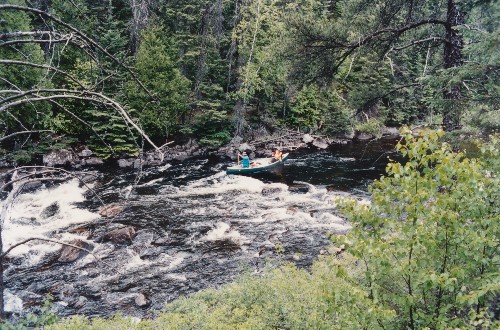
J. Brown
June, 1992
Edits and Summaries:
L. Walter
June, 2006